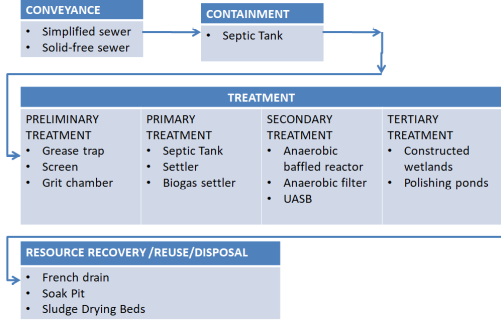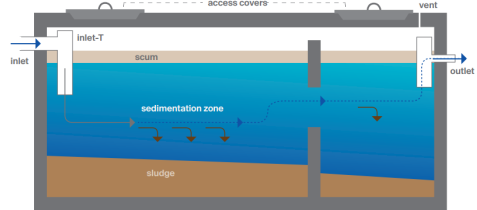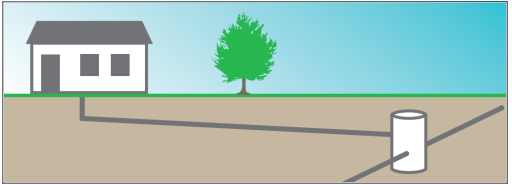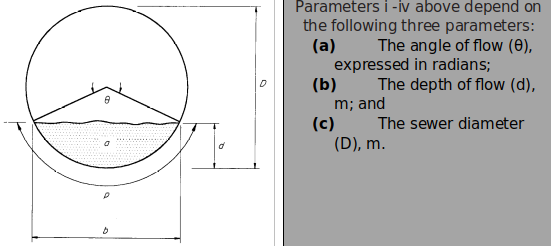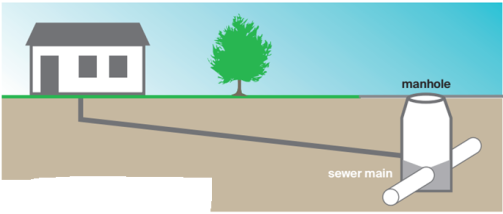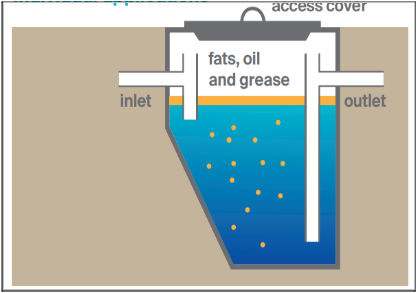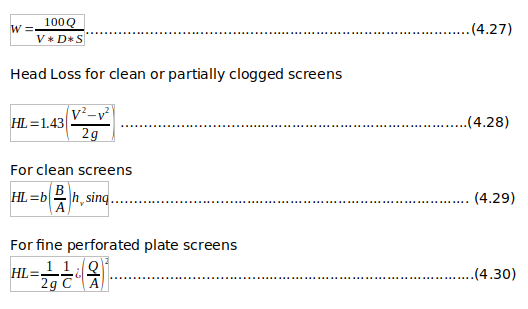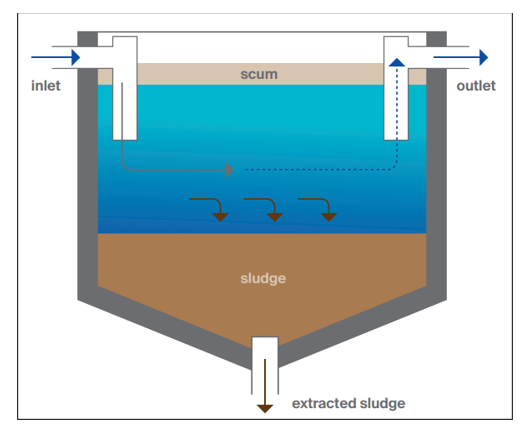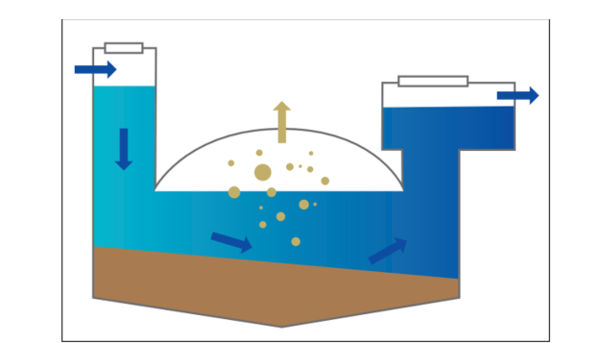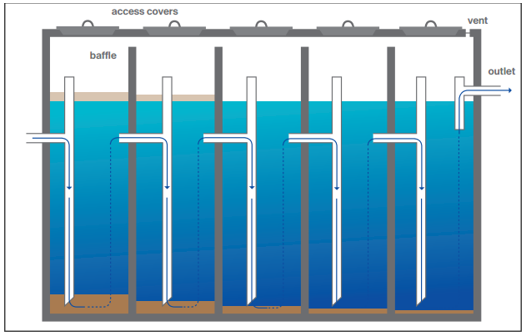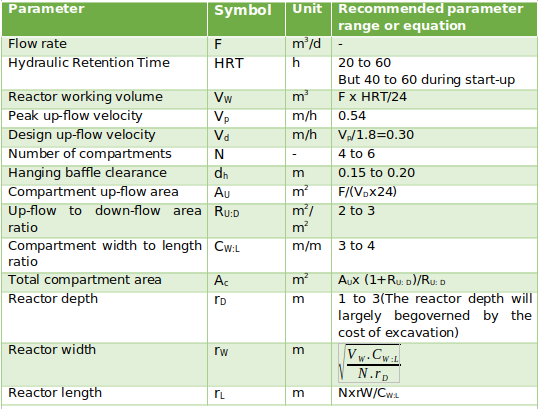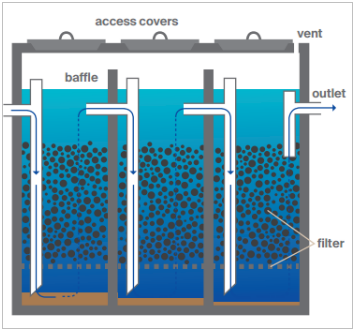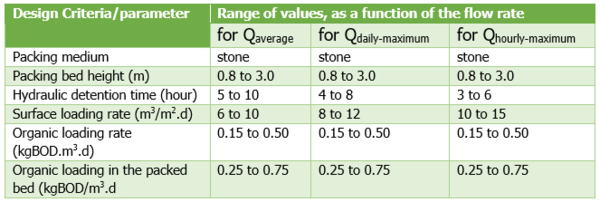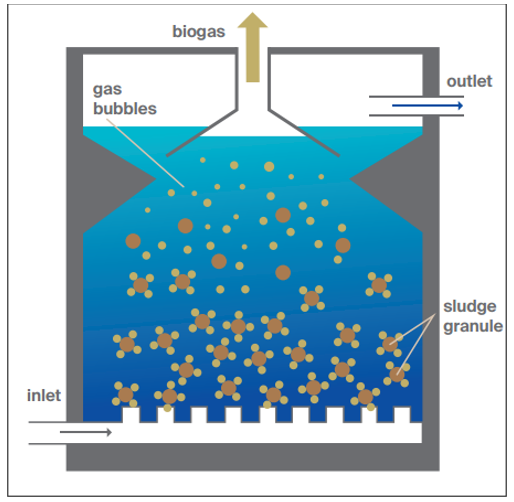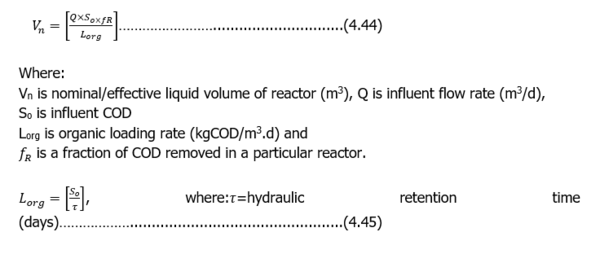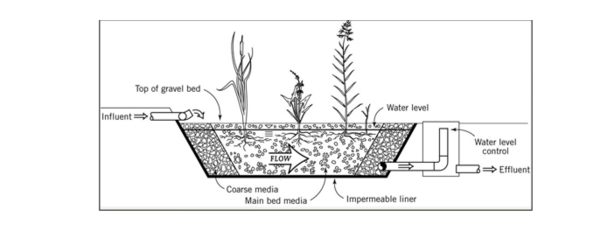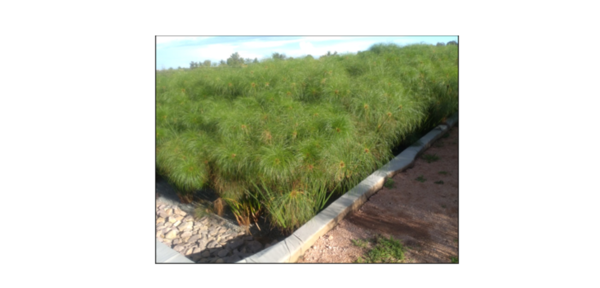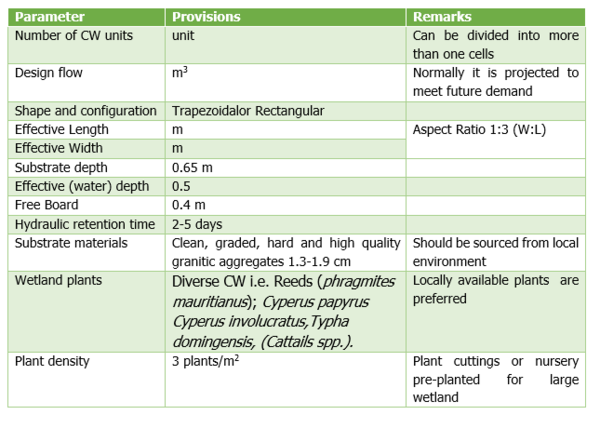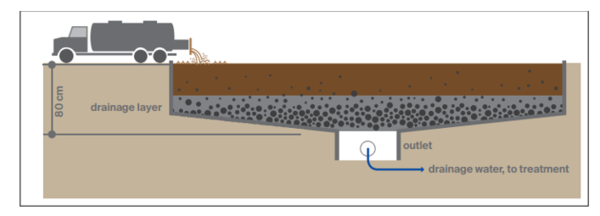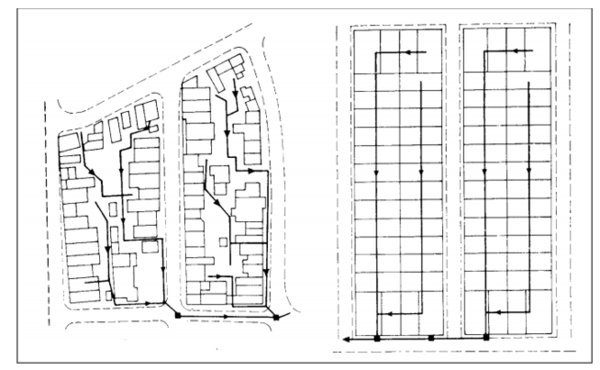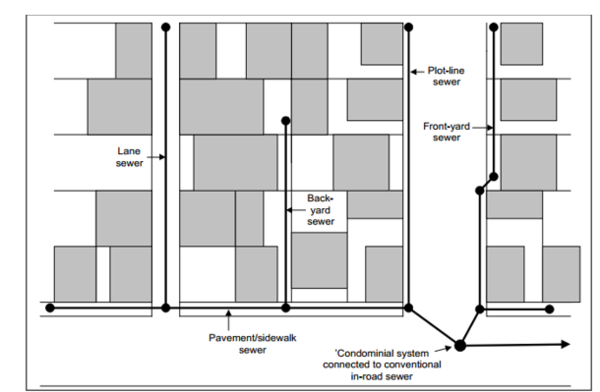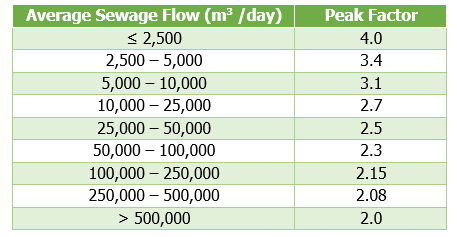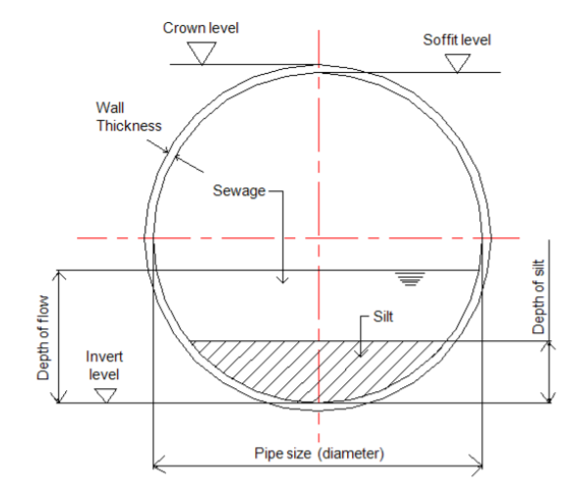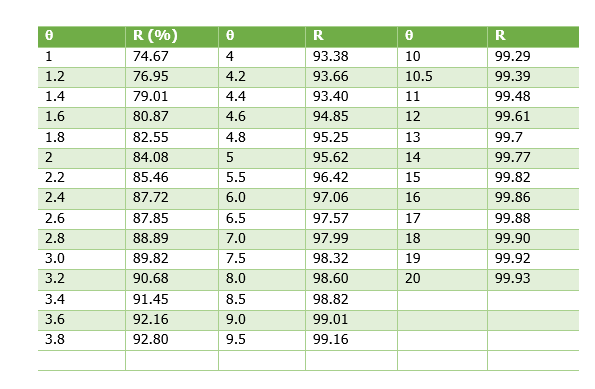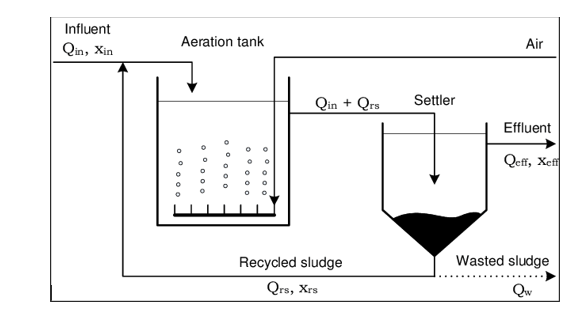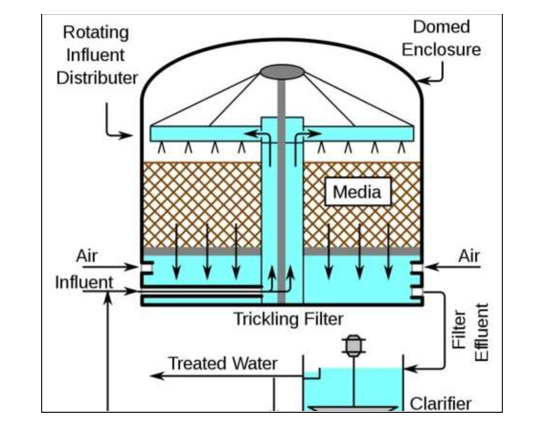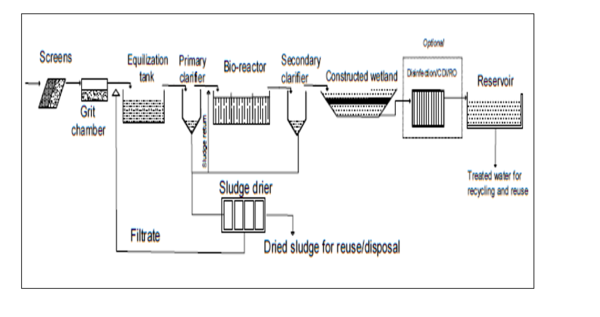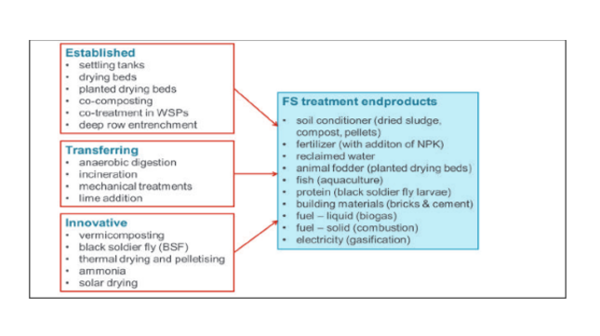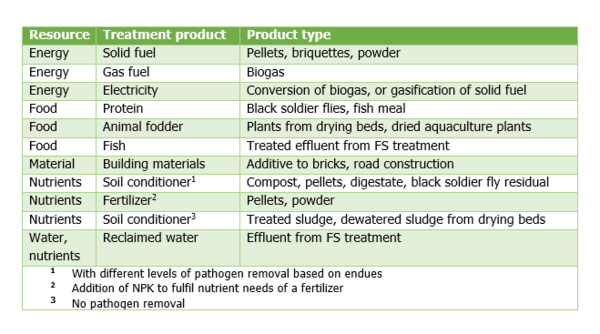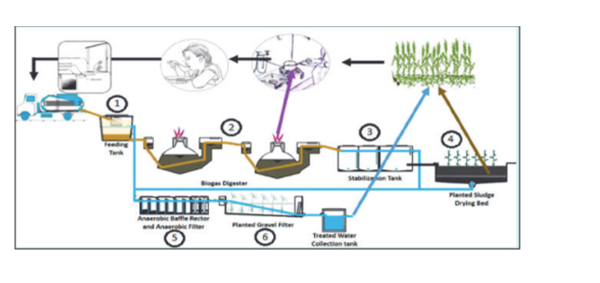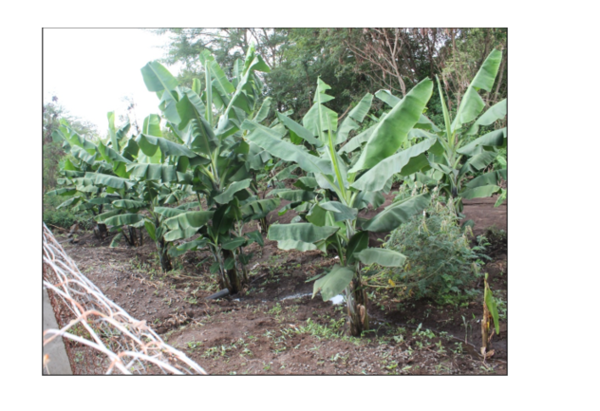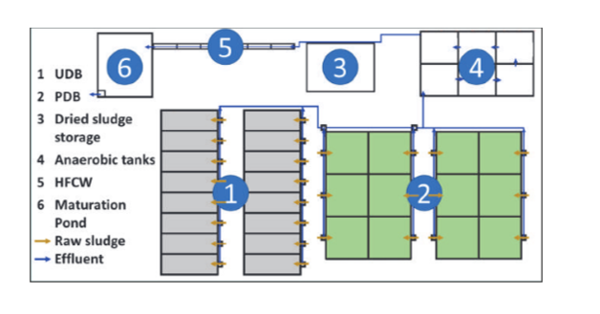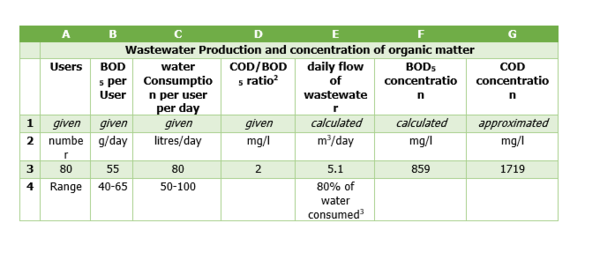Chapter Four: Off-Site Sanitation Systems:Chapter Four: Off-Site Sanitation Systems
Contents
- 1 Chapter Four: Off-site Sanitation Systems
- 1.1 Decentralized Wastewater Treatment Systems (DEWATS)
- 1.2 Components of DEWATS
- 1.2.1 Containment
- 1.2.2 Design of Septic Tank
- 1.2.3 Conveyance
- 1.2.4 Wastewater Treatment
- 1.2.5 Preliminary Treatment
- 1.3 Simplified Sewerage System (Condominial System)
- 1.4 Centralized Wastewater Treatment
- 1.5 Design guidelines for School WASH facilities
- 1.6 Design Guidelines for Health Care WASH Facilities
- 1.7 Design Guidelines/Options for Small Towns or Emerging Towns
- 1.8 Sanitation Resources Recovery and Reuse
- 1.8.1 Introduction
- 1.8.2 Fecal Sludge Treatment End Products
- 1.8.3 Application
- 1.8.4 Suitable FS Characteristics for Resource Recovery
- 1.8.5 Biogas
- 1.8.6 Animal feed
- 1.8.7 Treatment Technologies for Sanitation Resource Recovery and Re-use
- 1.8.8 Design Procedures for Treatment Technologies for Resources Recovery
- 1.9 Safeguarding of Sanitation Infrastructure
- 1.10 Application Software
- 1.11 Technical Spreadsheets
1 Chapter Four: Off-site Sanitation Systems
Off-site sanitation refers to a sanitation system in which wastewater and excreta are collected and conveyed away from the plot where they are generated. An off-site sanitation system relies on a sewer technology (simplified sewer, solid free sewer or conventional sewer) for conveyance of excreta.
1.1 Decentralized Wastewater Treatment Systems (DEWATS)
Decentralized wastewater management systems (DEWATS) include all parts of a onsite-sanitation system. In comparison to centralized systems, these systems are located at or near the point of wastewater generation. DEWATS can be characterized and differentiated from centralized systems along the following lines.
- Volume: Decentralized systems treat relatively small volumes of water (typically 1-1,000 m³/day),
- Sewer type: Centralized systems typically use conventional gravity sewers, while decentralized systems typically use small-diameter gravity sewers, often employing intermediate settlers for solid-free sewers.
1.2 Components of DEWATS
The components of DEWATS are presented in the schematic layout shown in Figure 4.1
Figure 4.27: Treatment Flow Sheet for Components of DEWATS (Source: MoW, 2018)
1.2.1 Containment
Containment technologies collect and store wastewater at the user interface on-site. Containment technologies are usually applicable for low-cost, non-sewered sanitation (FS) systems as intermediate storage, but can also serve as pre-treatment modules for small-scale wastewater treatment systems. The main containment technology applicable for wastewater treatment technologies is a septic tank (see Figure 4 .28).
Figure 4.28: The Cross Section of a Septic Tank
(Source: MoW, 2018)
In the vast majority of situations, containment systems are already installed on-site but are often improperly designed, constructed and maintained, which poses severe environmental hazards. Apart from septic tanks providing some degree of pre-treatment, the effluent usually contains high concentrations of pollutants, which can carry severe public health and environmental burdens, especially in densely populated urban areas and in the vicinity of drinking water sources. Hence, proper sealing of containment options is crucial for environmental sanitation. Containment systems can also be implemented to buffer peak flows.
1.2.2 Design of Septic Tank
The capacity of septic tank depends on number of users and interval of sludge removal. Normally sludge should be removed every 2 years. The liquid capacity of the tank is taken as 130 litres to 70 litres per head. For small number of users 130 litres per head is sufficient.
A septic tank is usually provided with brick walls in which cement mortar [not less than 20 cm (9 inch)] thick and the foundation floor is of cement concrete 1:2:4. Both inside and outside faces of the wall and top of the floor are plastered with minimum thickness of 12mm thick cement mortar 1:3 mix.
All inside corners of the septic tank are rounded. Water proofing agent (such as Impermo, Cem-seal or Accoproof, etc.) is added to the mortar at the rate of 2% of the cement weight. Water proofing agent is to be added in similar proportion in to the concrete also for making the floor of the tank.
For proper convenience in collection and removal of the sludge, the floor of the septic tank is given a slope of 1:10 to 1:20 towards the inlet side. Which means that the floor of the outlet side will be on the higher elevation than the floor at the inlet side.
1.2.2.1 Dimensioning a Septic Tank
(A) Length, Width and Depth of Septic Tank
Width = 750 mm (minimum)
Length = 2 to 4 times width
Depth = 1,000 to 1,300 mm. (min below water level) + 300 to 450 mm free board
Maximum depth = 1,800 mm + 450 mm free board
Capacity = 1 cubic metre (minimum)
(B) Detention period
Detention period of 24hrs (is mostly) considered in septic tank design. The rate of flow of effluent must be equal to the rate of flow of the influent.
(C) Inlet and outlet pipes
An elbow or T pipe of 100mm diameter is submerged to a depth of 250-600 mm below the liquid level. For the outlet pipe an elbow or T type of 100mm diameter pipe is submerged to a depth of 200-500 mm below the liquid level. Pipes may be of stone ware or asbestos or PVC.
(D) Baffle Walls of the Septic Tank
For small tanks, RCC hanging type scum baffle walls are provided in septic tanks. Baffle walls are provided near the inlet. It is optional near the outlet. The inlet baffle wall is placed at a distance of L/5 from the wall, where L is the length of the wall. The baffle wall is generally extended 150 mm above to scum level and 400-700 mm below it.
Scum being light, generally floats at the water level in the tank. Thickness of the wall varies from 50 mm to 100 mm. For large tanks the lower portion has holes for flow of sludge.
(E) Roofing Slab of the Septic Tank
The top of the septic tank is covered with a RCC slab of thickness of 75-100 mm depending upon the size of the tank. Circular manholes of 500mm clear diameter are provided for inspection and desludging. In case of rectangular opening clear size is kept as 600 x 450 mm.
(F) Ventilation Pipe
For outlet of foul gases and ventilation purpose cast iron or asbestos pipe of 50-100 mm diameter is provided which should extend 2m (minimum) above ground level. Top of the ventilation pipe is provided with a mosquito proof wire mesh or cowl.
1.2.3 Conveyance
Technologies presented in this section are sewer-based technologies, using water from waterborne toilets as a conveying medium.
1.2.3.1 Simplified Sewer
A simplified sewer describes a sewerage network that is constructed using smaller diameter pipes laid at a shallower depth and at a flatter gradient than conventional sewers (Figure 4.3).
Figure 4.29: Sketch of a Simplified Sewer
(Source: MoW, 2018)
This sewer system generally does not apply pumping. For this reason, a simplified sewer allows for a more flexible design at lower cost. Simplified sewers can be installed in almost all types of settlements and are especially appropriate for densely populated urban areas where space for on-site technologies is limited. The sewers should be considered as an option where there is significant population density (about 150 inhabitants per hectare) and a reliable water supply system (at least 60 L/capita/day).
1.2.3.1.1 Design considerations for simplified sewers
In contrast to conventional sewers that are designed to ensure a minimum self-cleansing velocity, the design of simplified sewers is based on a minimum tractive tension of 1 N/m2 (1 Pa) at peak flow. The minimum peak flow should be 1.5 L/s and a minimum sewer diameter of 100 mm is required. A gradient of 0.5% is usually sufficient. For example, a 100 mm sewer laid at a gradient of 1m in 200 m will serve around 2,800 users with a wastewater flow of 60 L/person/day. PVC pipes are recommended for use. The depth at which they should be laid depends mainly on the amount of traffic. Below sidewalks, soil covers of 40 to 65 cm are typical. The simplified design can also be applied to sewer mains. They can also be laid at a shallow depth, provided that they are placed away from traffic.
Expensive manholes are normally not needed. At each junction or change in direction, simple inspection chambers (or cleanouts) are provided as can be seen on Figure 4 .29. Inspection boxes are also used at each house connection. Where kitchen grey water contains an appreciable amount of oil and grease. The installation of grease traps is recommended to prevent clogging. Grey water should be discharged into the sewer to ensure adequate hydraulic loading, but storm water connections should be discouraged. In practice it is difficult to exclude all storm water flows, especially where there is no alternative for storm drainage. The design of sewers (and treatment plants) should, therefore, take into account the extra flow that may result from storm water inflows.
1.2.3.1.2 Design Procedures for Simplified Sewers
Step 1. Estimation of the wastewater flow
Daily peak flows
The value of the wastewater flow used for sewer design is the daily peak flow. This can be estimated as follows:
where: q = daily peak flow, l/s k1 = peak factor (=daily peak flow divided by average daily flow) k2 = return factor (=wastewater flow divided by water consumption) P = population served by length of sewer under consideration w = average water consumption, litres per person per day and 86,400 is the number of seconds in a day.
A suitable design value for k1 for simplified sewerage is 1.8 and k2 may be taken as 0.85.
Thus, equation 4.1 becomes:
Variations in the value of k2 have a much lower impact on design, except in middle and high-income areas where a large proportion of water consumption is also for lawn-watering and car-washing. In peri-urban areas in Brazil a k2 value of 0.85 has been used successfully, although other counties use a value of 0.65, even in low income areas and without any reported operational problems (Luduvice, 2000). However higher values may be more appropriate elsewhere–for example, in areas where the water supply is based on a system of public standpipes, values up to 0.95 may be used.
Step 2. Sizing of a simplified sewer
The flow in simplified sewers is always assumed to be an open channel flow–that is to say, there is always some free space above the flow of wastewater in the sewer. The hydraulic design of simplified sewers requires knowledge of the area of flow and the hydraulic radius. Both these parameters vary with the depth of flow.
From Figure 4 .30 shows the trigonometric relationships which can be derived for the following parameters:
(i) The area of flow(a), expressed in m2;
(ii) The wetted perimeter(p), m;
(iii) The hydraulic radius(r), m; and
(iv) The breadth of flow (b), m.
The hydraulic radius (sometimes called the hydraulic mean depth) is the area of flow divided by the wetted perimeter.
Figure 4.30: Definition of Parameters for Open Channel Flow in a Circular Sewer (Source: Mara, 1996)
If the angle of flow is measured in degrees, it must be converted to radians by multiplying by (2π/360), since 360o equals 2π radians.
The ratio d/D is termed the proportional depth of flow (which is dimensionless). In simplified sewerage systems the usual limits for d/D are as follows:
0.2 <d/D < 0.8
The lower limit ensures that there is sufficient velocity of flow to prevent solids deposition in the initial part of the design period, and the upper limit provides for sufficient ventilation at the end of the design period. The equations are as follows:
Angle of flow, θ = 2 cos-1 [1 – 2 (d/D)] .....................................................................(4.3)
Area of flow, a = D2 [(θ – sin θ) / 8] ..........................................................................(4.4)
Wetted perimeter, p = θ D/2 .....................................................................................(4.5)
Hydraulic radius (= a/p), r = (D/4) [1 – ((sin θ) /θ)]....................................................(4.6)
Breadth of flow, b = D sin (θ/2), ................................................................................(4.7)
When d = D (that is, when the sewer is flowing just flow), then a = A = π D2/4; p = P = πD and r = R = D/4.
The following equations for ‘’a’’ and ‘’r’’ are used in designing simplified sewers:
a =kaD .......................................................................................................................(4.8)
r = krD .......................................................................................................................(4.9)
.
The coefficients ka and kr are given from equations 4.8 and 4.9 as:
Step 3. Velocity of flow In 1889, Robert Manning (an Irish civil engineer, 1816-1897) presented his formula relating to the velocity of flow in a sewer to the sewer gradient and the hydraulic radius (Manning, 1890). The formula is commonly, but improperly, known as the Manning equation; as pointed out by Williams (1970) and Chanson (1999). it should be known as the Gauckler-Manning equation since Philippe Gauckler (a French civil engineer,1826-1905) published the same equation 4.12 years earlier (Gauckler, 1867 and1868).
The Gauckler-Manning equation is
Where
V = velocity of flow at d/D, m/s
n = Ganguillet-Kutter roughness coefficient, dimensionless
r = hydraulic radius at d/D, m
i = sewer gradient, m/m (i.e. dimensionless)
Since flow = area × velocity
Where q = flow in sewer at d/D, m3/s
Using equations 4.8 and 4.9, equation 4.14 becomes:
The usual design value of the Ganguillet - Kutter roughness coefficient, n is 0.013. This value is used for any relatively smooth sewer pipe material (concrete, PVC or vitrified clay) as it depends not so much on the roughness of the material itself, but on the roughness of the bacterial slime layer which grows on the sewer wall.
1.2.3.2 Solids-free Sewer
Solids-free sewers are also referred to as settled, small-bore, variable-grade gravity, or septic tank effluent gravity sewers. A precondition for solids-free sewers is efficient primary treatment at the household level. Figure 4 .31 presents section of solids free sewers.
Figure 4.31: Section of Solids Free Sewers (Source: Tilleyet al., 2014)
An interceptor, typically a single-chamber septic tank, captures settleable particles that could clog small pipes. The solids interceptor also functions to attenuate peak discharges. Because there is little risk of depositions and clogging, solids-free sewers do not have to be self-cleansing, i.e., no minimum flow velocity or tractive tension is needed. They require few inspection points, can have inflective gradients (i.e., negative slopes) and follow the topography. When the sewer roughly follows the ground contours, the flow is allowed to vary between open channel and pressure (full-bore) flow.
1.2.3.2.1 Design Considerations for Solid Free Sewers
If the interceptors are correctly designed and operated, this type of sewer does not require self-cleansing velocities or minimum slopes. Even inflective gradients are possible, as long as the downstream end of the sewer is lower than the upstream end. Solids-free sewers do not have to be installed on a uniform gradient with a straight alignment between inspection points. The alignment may curve to avoid obstacles, allowing for greater construction tolerance. At high points in sections with pressure flow, the pipes must be ventilated. A minimum diameter of 75 mm is required to facilitate cleaning.
Expensive manholes are not needed because access for mechanical cleaning equipment is not necessary. Cleanouts or flushing points are sufficient and are installed at upstream ends, high points, intersections, or major changes in direction or pipe size. Compared to manholes, cleanouts can be more tightly sealed to prevent storm water from entering. Storm water must be excluded as it could exceed pipe capacity and lead to blockages due to grit depositions. Ideally, there should not be any storm- and groundwater in the sewers, but, in practice, some imperfectly sealed pipe joints must be expected. Estimates of groundwater infiltration and storm water inflow must, therefore, be made when designing the system. The use of PVC pipes can minimize the risk of leakages.
1.2.3.2.2 Design Steps for Solids Free Sewers
A similar equation to simplified sewers can be used to design the size of a sewer in case of very large flow rate of the wastewater. The design of solids free sewers follows the following steps:
Step 1. Estimation of the waste water flow
Daily peak flows
The value of the wastewater flow used for sewer design is the daily peak flow. This can be estimated as follows:
where
q = daily peak flow, l/s k1 = peak factor (=daily peak flow divided by average daily flow) k2 = return factor (=wastewater flow divided by water consumption) P = population served by length of sewer under consideration w = average water consumption, litres per person per day and 86,400 is the number of seconds in a day
A suitable design value for k1 for simplified sewerage is 1.8 and k2 may be taken as 0.85.
Thus, equation 4.1 becomes;
q = 1.8 × 10-5P………………...........................................................................…...…(4.16)
Variations in the value of k2 have a much lower impact on design, except in middle and high-income areas where a large proportion of water consumption is used for lawn-watering and car-washing. In peri-urban areas in Brazil a k2 value of 0.85 has been used successfully, although other countries use a value of 0.65, even in low income areas and without any reported operational problems (Luduvice, 2,000). However higher values may be more appropriate elsewhere – for example, in areas where the water supply is based on a system of public standpipes, values up to 0.95 may be used.
Step 2: Sizing of conventional gravity sewers
The flow in simplified sewers is always assumed to be an open channel flow–that is to say, there is always some free space above the flow of wastewater in the sewer. The hydraulic design of conventional gravity sewers requires knowledge of the area of flow and the hydraulic radius. Both these parameters vary with the depth of flow. From figure below trigonometric relationships can be derived for the following parameters:
(a) The area of flow (a), expressed in m2;
(b) The wetted perimeter(p), m;
(c) The hydraulic radius (r), m; and
(d) The breadth of flow (b), m.
The hydraulic radius (sometimes called the hydraulic mean depth) is the area of flow divided by the wetted perimeter.
Figure 4.32: Definition of Parameters for Open Channel Flow in a Circular Sewer
(Source: Mara, 1996)
If the angle of flow is measured in degrees, then it must be converted to radians by multiplying by (2π/360), since 360o equals 2π radians. The ratio d/D is termed the proportional depth of flow (which is dimensionless). In simplified sewerage pipes the usual limits for d/D are as follows:
0.2 <d/D < 0.8
The lower limit ensures that there is sufficient velocity of flow to prevent solids deposition in the initial part of the design period, and the upper limit provides for sufficient ventilation at the end of the design period. The equations are as follows:
Angle of flow, θ = 2 cos-1 [1 – 2 (d/D)]………………….....…………..…......(4.17)
Area of flow, a = D2 [(θ – sin θ) / 8].....……..………………………...……….(4.18)
Wetted perimeter, p = θ D/2.........……………………………...…..................(4.19)
Hydraulic radius (= a/p), r = (D/4) [1 – ((sin θ) /θ)].....………….………........(4.20)
Breadth of flow, b = D sin (θ/2)......………………………………..……..……..(4.21)
When d = D (that is, when the sewer is flowing just flow), then a = A = π D2/4; p = P = πD and r = R = D/4.
The following equations for ‘’a’’ and ‘’r’’ are used in designing simplified sewers:
a = kaD2 ………………………………………………………………….........................(4.22)
r = krD……………………………….………………………..…………..........................(4.23)
The coefficients ka and kr are given from equations 4.22 and 4.23 as:
1.2.3.3 Conventional Gravity Sewer
Conventional gravity sewers are large networks of underground pipes that convey backwater, grey water and, in many cases, storm water from individual households to a (semi-)centralised treatment facility using gravity (and pumps when necessary). Schematic layout sketch of a conventional gravity sewer is presented in Figure 4 .33.
Figure 4.33: Schematic Layout Sketch of a Conventional Gravity Sewer
(Source: MoW, 2018)
Since they can be designed to carry large volumes, conventional gravity sewers are very appropriate to transport wastewater to a (semi-) centralised treatment facility. The construction of conventional sewer systems in dense, urban areas is complicated because it disrupts urban activities and traffic. Conventional gravity sewers are expensive to build and a professional management system must be in place, as the installation of a sewer line is disruptive and requires extensive coordination between related authorities, construction companies and property owners.
1.2.3.3.1 Design Considerations
Conventional gravity sewers normally do not require on-site pre-treatment, primary treatment or storage of the household wastewater before it is discharged. The sewer must be designed, however, such that it maintains self-cleansing velocity (i.e., a flow that will not allow particles to accumulate). For typical sewer diameter s, a minimum velocity of 0.6 to 0.7 m/s during peak dry weather conditions should be adopted. A constant downhill gradient must be guaranteed along the length of the sewer to maintain self-cleansing flows, which can require deep excavations. When a downhill grade cannot be maintained, a manhole must be installed. Primary sewers are laid beneath roads, at depths of 1.5 to 3 m to avoid damages caused by traffic loads. The depth also depends on the groundwater table, the lowest point to be served (e.g., a basement) and the topography. The selection of the pipe diameter depends on the projected average and peak flows. Commonly used materials are concrete, PVC, and ductile or cast iron pipes.
Access manholes are placed at set intervals above the sewer, at pipe intersections and at changes in pipeline direction (vertically and horizontally). Manholes should be designed such that they do not become a source of storm water inflow or groundwater infiltration.
1.2.3.3.2 Design Steps for Conventional Gravity Sewers
The design steps for the conventional gravity sewers should be the same as those for simplified and solids free sewers. In addition, the design for the system should allow for weir for discharge measurements. Please refer to these sections for the design of conventional gravity sewers. For conventional gravity sewer lines, the following should be observed on the pipe sizes to be applied because of potential abuse by users by introducing solids into the sewer lines:
(a) Any new sewer connection should use plastic pipes of diameter not less than 150 mm or (6") for further extensions (limited number of connected customers not more than 5 in number for domestic use only). (b) Lateral sewers, incorporating more than 5 sewer connections and that may need further extensions in future should involve plastic pipes of diameter not less than 200 mm or (8"). (c) Commercial and public sewer connections at lodges, hotels, business centres, institutions, industries, apartments and others should use plastic pipes of not less than 200 mm (8"). (d) All main sewers should start with pipes not less than 200 mm (8").
Note that: The previously designed plastic pipes of more than 500 mm were discouraged to provide room for concrete pipes from that diameter. From field practical experience concrete pipes have higher roughness than plastic pipes and are easily corroded by sewage. Plastic pipes of various diameters and appurtenances for application in sewerage lines are currently manufactured and available in Tanzania.
1.2.4 Wastewater Treatment
Wastewater treatment is a process used to remove contaminants from wastewater or sewage and convert it into an effluent that can be returned to the water cycle with minimum impact on the environment, or directly reused (https://en.wikipedia.org/wiki/Wastewater_treatment). The typical wastewater treatment flow sheet is presented Figure 4 .34.
Figure 4.34: A Typical Flow Sheet for a Wastewater Treatment Plant
(Source: MoW, 2018)
1.2.5 Preliminary Treatment
1.2.5.1 Grease Trap
Fats, oils and grease are a major component of human food stuffs. The term 'grease' is commonly used and sometimes includes the fats, oils, waxes, and other related constituents found in waste water. Greases are solid products (as long as the temperature is sufficiently low) of animal or vegetable origin present in municipal waste water and in some industrial waste waters.
At municipal and industrial wastewater treatment plants where large quantities of grease and fat are to be removed, both aided and induced flotation systems are used to separate the grease and fat from the sewage. These systems involve the use of gas (normally air) bubbles to promote the separation of fat and grease particles from the liquid medium in which they are carried. The rising velocity of the gas bubble determines the efficiency of removal of grease and fat. shows section view of a grease trap. The rising velocity of the gas bubble This is sometimes calculated from Stokes equation which is as follows:
Stokes Equation
Where:
V = the rising velocity;
d = diameter of air bubbles;
Pg = density of the gas;
Pi= density of the liquid:
n= absolute viscosity; and
g = gravitational acceleration
Figure 4.35: Section View of a Grease Trap (Source: Tilley et al., 2014)
1.2.5.2 Design Considerations for Grease Trap
The minimum requirements for grease trap design are:
(a) Provision of sufficient capacity to slowdown the passing wastewater, giving greasy waste, the opportunity to separate out. Check the size of an existing grease trap or determine the approximate size of a new grease trap.
(b) The length of the trap should be equal to between 1.3 and 2.0 times the total depth. Note that usually, the grease trap contents occupy 2/3 of the total depth; the top 1/3 of the trap is head space. Do not include wall and cover thickness in the length and depth measurements if the grease trap is built of concrete.
(c) The surface area of the trap (the length times the width in square millimetres) should be equal to between 1,000 and 2,000 times the total depth measured in millimetres. Again, do not include wall and cover thickness in measuring a concrete trap.
(d) Prevent wastewater entering the grease trap from mixing up the top greasy waste layer. A baffle should be present at the trap inlet to slow down the incoming wastewater and keep it separate from the top waste layer. The inlet pipe should end in a 90° downwards bend so that incoming wastewater enters the trap at least 100 mm below the water surface. The inlet pipe should not terminate above the liquid surface such that wastewater drops into the trap.
(e) Allow access to the trap for maintenance so that all covers can be lifted and accumulated material removed from both the top and bottom of the trap. Except for very large grease traps, the total depth of liquid should never exceed 1200 mm. A sampling hole with an appropriate cover must also be provided if the opening for maintenance access does not also give access to the grease trap outlet.
(f) Provide necessary safety features. All grease traps must be vented. Under-floor grease traps and grease traps with over 1000 litre capacity must be provided with a prominent sign to show location, to indicate both total and liquid depth, and the maximum allowable thickness of the greasy waste layer (30%).
1.2.5.3 Screens
Screening is the first unit operation used at wastewater treatment plants (WWTPs). Screening removes objects such as rags, paper, plastics, and metals to prevent damage and clogging of downstream equipment, piping, and appurtenances. Some modern wastewater treatment plants use both coarse screens and fine screens.
(a) Coarse Screens
Coarse screens remove large solids, rags, and debris from wastewater, and typically have openings of 6 mm (0.25 in) or larger. Types of coarse screens include mechanically and manually cleaned bar screens, including trash racks. Table 4.1 provide a description of wastewater screen types.
Table 4.25: Description of Coarse Screens
| Screen Type | Description |
|---|---|
| Trash rack | Designed to prevent logs, timbers, stumps, and other large debris from entering treatment processes. Opening size: 38 to 150 mm |
| Manually cleaned bar screen | Designed to remove large solids, rags, and debris. Opening size: 30 to 50 mm Bars are set at 30 to 45 degrees from vertical to facilitate cleaning. Primarily used in older or smaller treatment facilities, or in bypass channels |
| Mechanically cleaned bar screen | Designed to remove large solids, rags, and debris. Opening size: 6 to 38mm Bars are set at 0 to 30 degrees from vertical. Almost always used in new installations because of a large number of advantages relative to other screens. |
(b) Fine Screens
Fine screens are typically used to remove material that may create operation and maintenance problems in downstream processes, particularly in systems that lack primary treatment. Typical opening sizes for fine screens are 1.5 to 6 mm. Very fine screens with openings of 0.2 to 1.5 mm placed after coarse or fine screens can reduce suspended solids to levels near those achieved by primary clarification.
(c) Screen Design Steps
Step 1: Selection
The specific screen to be selected will depend on the application. In general, the approach as set out in Table 4 .26is suggested.
Table 4.26: Screen Selection
| Application | Aperture | Type |
|---|---|---|
| Large Pump houses | 50 - 15 mm | Trash rack R.B.I. |
| Small Pump houses | 50 mm | Liftable cage Bar screen |
| Small Wastewater Treatment Plants (Without Sludge Treatment) | 15 - 25 mm | Curved bar screen Vertical bar screen Inclined bar screen |
| Small Wastewater Treatment Plant (With Sludge Treatment) | 5 - 10 mm | Inclined bar screen Vertical bar screen Band screen |
| Medium Wastewater Treatment Plant (With Sludge Treatment) | 5 - 10 mm | Inclined bar screen Vertical bar screen Band screen Screezer (V.D.S.) Rotomat Contra-shear |
| Large Wastewater Treatment Plants (With Sludge Treatment) | 15 - 50mm (Before Fine Screen) | Vertical bar screen |
| 5 - 10 mm | Band screen Drum screen Cup screen. Screezer (V.D.S.) Rotomat. Contra-shear | |
| Overflows (Retain Screenings in Foul Flow) | 5 - 10 mm | Discreen J&A Weir Mount |
(Source: Clay et al., 1996)
(d) Design Factor for Screens
The basic design of a bar screen should be such that the velocity through the screen would he sufficient for matter to attach itself to the screen without producing an excessive loss of head or complete clogging of the bars. At the same time, velocities in the channel upstream should be sufficient to avoid deposition of solids. In all cases the shape of the bar should be tapered from the upstream side so that any solids which pass the upstream face of the screen cannot be jammed in the screen, thereby causing a trip out of the raking mechanism. Table 4 .27 gives the design factors for bar screens:
Table 4.27: Bar Screen Design Factors
| Item | Manually cleaned | Mechanically cleaned |
|---|---|---|
| Bar Size: Width (mm) Depth (mm) |
5 - 15 25 - 80 |
5- 15 25 - 80 |
| Aperture (mm) | 20 - 50 | 5 - 80 |
| Slope to Flow (Deg) | 450 - 600 | 180 - 900 |
| Velocity Through Screen (m/s) | 0.3 - 0.6 | 0.6 - 1.0 (Max. 1.4) |
(Source: Clay et al., 1996)
The following equations may be used for standard bar screens to calculate the width of channel required and the head loss through the screen:
Width of Channel, W can be calculated as follows;
Where Q = Maximum Flow (m3Is) V = Velocity Through Screen (mis) v = Velocity in Upstream Channel (m/s) D = Depth of Flow (m) W = Width of Channel (m) S = % Screen Open Area. HL = Head Loss Through Screen (m) g = 9.81 m/s2 (gravity). h = Head on Screen Upstream (m) A = Submerged Aperture Area (mm2) B = Bar Width (mm) ɵ = Angle of inclination of bars. C = Coefficient which should be checked with the manufacturer. ß= Bar Shape Factor.
The values of bar shape factors for clean rack are summarised as presented in Table 4 .28.
Table 4.28: Bar Shape Factor
| Bar type | Bar shape factor |
|---|---|
| Sharp-edged rectangular | 2.42 |
| Rectangular with semi- circular upstream face. | 1.83 |
| Circular. | 1.79 |
| Rectangular with semi- circular upstream and downstream faces. | 1.67 |
| Tear shape. | 0.76 |
1.2.5.3.1 Comminutors and Grinders
Processing coarse solids reduces their size so they can be removed during downstream treatment operations, such as primary clarification, where both floating and settleable solids are removed. Comminuting and grinding devices are installed in the wastewater flow channel to grind and shred material up to 6 to 19 mm in size. Comminutors consist of a rotating slotted cylinder through which wastewater flow passes. Solids that are too large to pass through the slots are cut by blades as the cylinder rotates, reducing their size until they pass through the slot openings.
Grinders consist of two sets of counter-rotating, intermeshing cutters that trap and shear wastewater solids into a consistent particle size, typically 6 mm (0.25 in). The cutters are mounted on two drive shafts with intermediate spacers. The shafts counter-rotate at different speeds to clean the cutters. The chopping action of the grinder reduces the formation of rag “balls” and rag “ropes” (an inherent problem with comminutors). Wastewaters that contain large quantities of rags and solids, such as prison wastewaters, utilize grinders downstream from coarse screens to help prevent frequent jamming and excessive wear. Caution: A designer must satisfy oneself as to why the materials need to be shredded down into small pieces and eventually design how to remove them from the wastewaters.
1.2.5.3.2 Grit Chamber
Grit consists of sand, gravel, stones, soil, cinders, bone chips, coffee grounds, seeds, eggshells, glass fragments, metals and other materials present in wastewater which do not putrefy. In general, grit as defined above has a specific gravity between 1.5 and 2.7 as opposed to a specific gravity for organics of approximately 1.02. In addition, grit settles as discrete particles, rather than as flocculant solids which is the case with organics.
Grit consists of discrete particles which settle independent of one another with a constant velocity. When a discrete particle is left alone in a liquid at rest, it is subjected to a settlement force of gravity and to a resistance resulting from the viscosity of the fluid and inertia. For any given size and density of particle, there is a particular settling velocity. This settling velocity is changed somewhat when the liquid in which the particle is contained is subjected to a horizontal velocity. Grit settlement is generally regarded as following Stokes' Law which may be stated as:
Stokes Law
Where:
Vn = settling velocity (m/s):
g = gravitational acceleration (m/s2):
n= viscosity of liquid (kg/ms): Table 4 .37 Comparison of LRTF and HRTF
ls = density of particle (kg/m3):
li= density of liquid (kg/m3): and
d = diameter of particle (m)
1.2.5.4 Primary Treatment
1.2.5.4.1 Septic Tanks
Please refer to the section 4.2.2 on the design of septic tank as a primary treatment
1.2.5.4.2 Settler/Clarifier/Sedimentation Tank
The main purpose of a settler is to facilitate sedimentation by reducing the velocity and turbulence of the wastewater stream. Settlers are circular or rectangular tanks that are typically designed for a hydraulic retention time of 1.5-2.5 h. Less time is needed if the BOD level should not be too low for the next biological step. The tank should be designed to ensure satisfactory performance at peak flow. In order to prevent eddy currents and short-circuiting, as well as to retain scum inside the basin, a good inlet and outlet construction with an efficient distribution and collection system (baffles, weirs or T-shaped pipes) is important.
Depending on the design selected, desludging can be done using a hand pump, airlift, vacuum pump, or by gravity using a bottom outlet. Large primary clarifiers are often equipped with mechanical collectors that continually scrape the settled solids towards a sludge hopper in the base of the tank, from where it is pumped to sludge treatment facilities. A sufficiently sloped tank bottom facilitates sludge removal. Scum removal can also be done either manually or by a collection mechanism. presents a typical cross section through the settler. The design considerations and procedures should follow like those ones for grit chamber.
Figure 4.36: Section View of a Settler
(Source: adapted from Tilley, et al., 2014)
1.2.5.4.3 Biogas Settler
A DEWATS Biogas Settler is usually a gas- and watertight dome-shaped sub-surface structure. It is typically constructed with bricks or cement mortar/plaster. The primary function of the settler is to separate the incoming wastewater into liquid and solid components, and so allowing the digestion of organic solids.
Figure 4.37: Biogas Settler (Source: Tilley et al., 2014)
The microbial digestion process occurs under anaerobic conditions (without oxygen) and results in the generation of biogas. The by-products of this process are (a) a digested slurry (digestate) that is stabilised and thus can be used as a soil amendment and (b) biogas that can be used for energy production. Biogas is a mixture of methane, carbon dioxide and other trace gases which can be converted to heat, electricity or light. presents a schematic sketch of a biogas settler.
1.2.5.4.4 Design Principles of a Biogas Settler
Biogas settlers are similar in construction and design as a fixed-dome or floating drum biogas plants. However, in opposition to biogas reactors, biogas settlers are designed for the retention of biomass and are thus typical high-rate biogas reactors. Other high-rate biogas plants are Anaerobic Baffled Reactors ABRs; Anaerobic Filters AF; and Up-flow Anaerobic Sludge Blanket Reactors (UASB). High-rate biogas reactors are characterized by a mixed flow regime: the liquid (e.g. flushing, anal cleansing or grey water) flows through (continuous flow), while the sludge (e.g. faeces, paper etc.) is retained (batch) and treated over a long time until it is removed and used as fertilizer. Thus, biogas settlers are characterized by relatively short hydraulic retention times (HRT) for the liquor and high sludge retention times (SRT) for the solid fraction (organic and inorganic). The settled sludge is transformed into biogas by anaerobic digestion). Gas bubbles to the top of the reactor are collected for use. At this point it is important to note that much of the design details can be refined through greater experience and empirical data. The following instructions are only a suggestion of design techniques brought together from a number of published articles.
Digester (including gas holder)
The size of the digester largely depends on the amount of waste to be added. Digester shape should enable a minimum surface area: volume ratio to be reached to reduce heat loss and construction costs. Hemispherical digesters with a conical floor often work best. To calculate the required digester volume (VD) use Equation 4.32:
VD = VB x HRT ………………………………………………………………...............(4.32)
Where:
VD = Volume of the digester (m3)
VB = Volume of biomass added per day (m3/day)
HRT = Retention time required (days)
The amount of human waste produced varies from person to person but generally lies in the region of 0.2-0.4kg (solid) and 1-1.3kg (liquid) per day (depending on diet, health, etc.). If other waste (animal dung, organic food waste, etc.) is added then this should also be taken into account. Clearly it is almost impossible to control the rates of waste input (especially in the case of latrines) so some discretion and common sense should be used when dealing with the numbers.
The volume of the gas holder VG depends on the relative rates of gas production and consumption. To calculate the daily gas production (G) either Equation 4.33or Equation 4.34 can be used (it may be good to use both and take an average since data for Gy varies greatly):
G = MB x Gy (moist mass) ………………………………………………………......(4.33)
G = LSU x Gy (species) ………………………………………………..………….(4.34)
Where:
G = Daily gas production rate (m3/day)
MB = Mass of biomass added per day (kg/day)
LSU = Number of livestock units (number)
Gy (moist mass) = Gas yield per kg of excreta per day (m3/kg/day)
Gy (species) =Gas yield per kg of livestock unit per day(m3/kg/day)
The gas holder must be designed such as to cover the peak consumption rate (VG1) (if the primary reason for construction is based on biogas demand) and the longest period of zero consumption (VG2) (if the primary reason for construction is safe excreta treatment/disposal). The larger of these 2 volumes should be used to specify the gas holder volume with an additional 20% safety margin. The following equations should be used to calculate VG1and VG2
VG1 = Gcmax x Tcmax ………………………………………………………... (4.35)
VG2 = G x Tczero ………………………………………………………………... (4.36)
Where:
VG1= Gas holder volume 1 (m3)
VG2= Gas holder volume 2 (m3)
Gcmax= Maximum rate of gas consumption (m3/day)
Tcmax= Maximum time of gas consumption (days)
G = Daily gas production rate (m3/day)
Tczero= Maximum time of zero gas consumption (days)
Based on experience the ratio of digester volume: gas holder volume (i.e. VD:VG) usually lies in the range 3-10:1. Since the hemispherical design of the fixed-dome generator combines the digester volume (VD) with the gas holder volume (VG), the total volume of the hemispherical dome (VH) can then be calculated:
VH = VDVG………………………………………………………………………… (4.37)
The final part of the calculation is to determine the required radius (r) of the hemisphere. This can be done using Equation 4.38:
r=((3Vh)/ (2)) 1/3 ………………………………………………………………… (4.38)
NB: Any calculated value should be taken as only an estimate–there are so many variables in the inputs (Hydraulic Retention Time (HRT), waste addition rate, gas consumption rate, climate, etc.) so the value should be used with caution.
Displacement tank –There are a number of different options for the design (size, shape, etc.) of displacement tanks. The tank could be a fully buried hemispherical structure (much the same as but smaller than the digester), a simple column tank or a large open drying bed. Available materials, workforce skills level, safety and space are factors which need assessing before choosing a befitting design. The primary functions of the displacement tank are to provide a buffer for the pressure of the gas inside the digester and to allow digested slurry to be removed. The main parameters of the design are volume of the tank and height of the slurry overflow. The required size largely depends on the fluctuation in gas volume/pressure over time (e.g. 1 day). If the gas volume fluctuates a large amount then a large tank is required to prevent too much slurry being lost through the overflow during times of high gas pressure (which will cause a low pressure of the next batch/collection of gas). If the gas volume does not fluctuate at all (e.g. rates of gas production/use are the same) then in theory a displacement tank may not be needed at all (which is unlikely). According to experience the volume of the displacement tank should be roughly equal to that of the gasholder. However, there is a lot of variance between designs since the shape of the displacement tank can vary so much (from a simple self-contained tank with an overflow to a large drying bed structure).
1.2.5.5 Secondary Treatment
1.2.5.5.1 Anaerobic Baffled Reactor
An ABR () is a modified septic tank with a series of baffles under which the wastewater is forced to flow. The increased contact time with the active biomass (sludge) results in improved treatment. The up-flow chambers provide enhanced removal and digestion of organic matter. The BOD can be reduced by 70% to 90%, which is far superior to its removal in a conventional septic tank. The main function of an ABR is the conversion of particulate matter into soluble BOD, as well as a certain percentage of soluble BOD into Methane (CH4). This is achieved by de-coupling HRT from Solids Retention Time.
Figure 4.38: Section View of an ABR (Source: Tilley, 2014).
(a) Design Parameters
The classic ABR process design consists of a number of equally dimensioned compartments. For a specific wastewater flow, the design is fully specified by fixing the following six independent parameters:
(i) Design hydraulic retention time,
(ii) Number of compartments,
(iii) Peak up-flow velocity,
(iv) Compartment width to length ratio,
(v) Reactor depth and
(vi) Compartment up-flow to down-flow area ratio.
The civil design of the reactor interior also requires values for hanging baffle clearance, headspace height, baffle construction and inlet and outlet construction. All other internal features such as length and width individual compartments dimensions are dependent on the first six parameters.
Fixing the design
Table 4 .29presents the recommended ranges for the values needed for the design parameters for an ABR treating domestic wastewater. Although the limits of operation have not been fully tested, these values have been selected based on experiences gained through 5 years of observing laboratory-and pilot-scale reactors in operation.
Table 4.29: Recommended Ranges for Parameters in the Design of an ABR (Source: Foxon et al., 2004)
1.2.5.5.2 Anaerobic Filter (AF)
An AF () is a fixed-bed reactor in an anaerobic contact process, with one or more filtration chambers in series. As wastewater flows through the filter, particles are trapped and organic matter is degraded by the active biomass that is attached to the surface of the filter material. Filter material can be gravel, rocks or specially formed plastic pellets. To reduce costs, locally available material shall be used. For example, in Tanzania, coconut husks can be used or in Indonesia volcanic rock might be a good solution. Good filter material provides 90m2 to 300m2 surface area per m3. With this technology, TSS and BOD removal can be as high as 90%, but typically ranges between 50% and 80%. Nitrogen removal is limited and normally does not exceed 15% in terms of total nitrogen (TN).
Figure 4.39: Section of an AF (Source: Tilley, 2014)
(b) Design criteria and procedures
The use of AFs for the treatment of domestic wastewater has been intended mainly for the polishing of effluents from septic tanks, UASB reactors and ABRs. In this configuration, the main design consideration is described below:
(c) Hydraulic detention time
The hydraulic detention time refers to the average time of residence of the liquid inside the filter, calculated by the following expression:
(d) Temperature
Anaerobic filters can be satisfactorily operated at temperatures ranging from 25 to 38oC. Usually, the degradation of complex wastewater, whose first stage of the fermentation process is hydrolysis, requires temperature higher than 25oC. Otherwise, hydrolysis may become the limiting stage of the process.
(e) Packing medium height
Based on the Brazilian experience, it is recommended for most applications that the packed bed height should be between 0.8 and 3.0 m. The upper height limit of the packed bed is more appropriate for reactors with lower risk of bed obstruction, which depends mostly on the flow direction, on the type packing material and on the influent concentrations. Amore usual value should amount to approximately 1.5 m.
(f) Hydraulic Loading rate
The hydraulic loading rate to the volume of wastewater applied daily per unit area of the filter packing medium, can be calculated by equation 4.40.
(g) Organic Loading rate
The volumetric organic loading rate refers to the load of organic matter applied daily per unit volume of the filter or packing medium, as calculated by Equation 4.41
Effluent distribution and collection systems
A very important aspect of the design of AFs concerns the detailing of the wastewater inlet and outlet devices, since the efficiency of the treatment system depends substantially on the good distribution of the flow on the packing bed, and this distribution is subject to the correct calculation of the inlet and outlet devices.
In the case of Up-flow Anaerobic Filters, the flow distribution tube has been used for every 2.0 to 4.0m2 of filter bottom area. shows the wastewater distribution device, through perforated tubes, and the effluent collection launder.
Figure 4.40: (a) and (b) Sewage Distribution Device at the Bottom of an AF and Effluent Collection Launder on the Top of the AF
(h) Efficiency of Anaerobic Filters
The expected efficiencies for AFs can be estimated from the performance relationship presented in equation 4.42
In situations where anaerobic filters are used as post-treatment units for effluents from septic tanks and UASB reactors, the BOD removal efficiency expected for the system as a whole varies from 75% to 85%.
From the efficiency expected for the system, the COD or BOD concentration in the final effluent can be estimated as follows:
Table 4.30: Design Criteria for Anaerobic Filters Applied to the Post-treatment of Effluents from Anaerobic Reactors (Source: Tilley et al., 2014)
1.2.5.5.3 Up-flow Anaerobic Sludge Blanket Reactor (UASB)
The UASB (Figure 4 .41) is a single-tank process. Wastewater enters the reactor from the bottom and flows upward. A suspended sludge blanket filters and treats the wastewater as the wastewater flow through it.
A UASB is not appropriate for small or rural communities without a constant water supply or electricity. The technology is relatively simple to design and build, but developing the granulated sludge may take several months. The UASB has the potential to produce higher quality effluent than septic tanks and a Biogas Settler and can do so in a smaller reactor volume. Although it is a well-established process for large-scale industrial wastewater treatment and high organic loading rates up to 10 kg BOD/m3/d, its application to domestic sewage is still relatively new.
Figure 4.41: Section View of an UASB Reactor (Source: Tilley et al., 2014)
Design procedures for UASB Reactor
Determine nominal volume of UASB Reactor
Determine total liquid volume of UASB Reactor
Consider factor of effectiveness = 0.80
Where:
VL, total liquid volume of the reactor (m3),
E the effectiveness factor (unit less).
Find out an area of UASB Reactor
Calculate Diameter of UASB Reactor
Find out the new volume of reactor
Determine the total Liquid Height of the UASB Reactor
The gas collection volume is additional to the reactor volume and adds an additional height of 2.5 m-3 m; hence the total height of the reactor is given by:
Where
HT is the total height of the reactor (m) and
HG is the total height of the gas collection and storage (m).
Calculate hydraulic Retention Time (HRT) in UASB Reactor
The hydraulic retention time,τ is given by:
The Sludge Retention Time (SRT) in UASB
The value of SRT can be estimated by assuming that all the wasted biological solids are in the effluent. The design approach is to assume that the given effluent VSS concentration consists of biomass (Metcalf and Eddy, 2004).
The Solid Wasted
Where:
Q flow rate m3/d and
Xe is particulate COD.
Where:
y = Biomass yield M of cell formed per M of substrate consumed
kd= Endogenous decay coefficient
fd =Fraction of cell mass remaining as cell debris=VSS cell debris/g VSS biomass decay
nbVSS = non-biodegradable volatile suspended solids, mg/L
So = Initial substrate concentration (COD) at time t = 0, mg/L,
S = Substrate concentration (COD) at time t, mg/L
SRT = Sludge Retention Time, d
μm = Maximum growth rate.
Data for Determining SRT
Effluent COD (S) at COD removal efficiency
Where:
S is effluent COD, mg/l, So is influent COD, mg/l and
ξ is reactor COD removal efficiency
The effluent VSS concentration
Consider that efficiency (ε) 50% of influent VSS is degraded (Metcalf and Eddy, 2004)
The particulate COD (Xe)
Consider at efficiency (ε) 50% of COD degraded (Metcalf and Eddy, 2004).
Solve for SRT
Effluent COD due to calculated SRT
Check for adequacy of computed SRT
If the fraction of CODinfl in effluent is higher than 15% remaining in effluent, then the process SRT is inadequate.
Check for concentration in biomass zone of the UASB reactor (XTSS)
The recommended range is 50-100g/L at bottom of reactor and 5-40g/L in a more diffuse zone at the top of the UASB sludge blanket (Metcalf and Eddy, 2004).
Effluents BOD5
Since, the ratio of COD to BOD5 for industrial wastewater can be approximated as 2-2.5
(COD = 2.25BOD5), hence;
1.2.5.6 Tertiary Treatment
1.2.5.6.1 Horizontal Subsurface Flow Constructed Wetland
A Horizontal Sub-Surface Flow Constructed Wetland (HSSF-CW) (Figure 4 .42) also known as Planted Gravel Filter is a large gravel and sand-filled basin that is planted with wetland vegetation. As wastewater flows horizontally through the basin, the filter material filters out particles and micro-organisms degrade the organics. The filter media acts simultaneously as a filter for removing solids, a fixed surface upon which bacteria can attach, and a base for the vegetation. Although facultative and anaerobic bacteria degrade most organics, the vegetation transfers a small amount of oxygen to the root zone so that aerobic bacteria can colonise the area and degrade organics there as well. The plant roots play an important role in maintaining the permeability of the filter. This technology has been intensively researched at UDSM since early 1990 (IWSA Conference Proceedings, Vol I and II, 2002). Several systems have been installed in Tanzania (Figure 4 .43).
Figure 4.42: Section View of a Horizontal Sub-surface Flow Constructed Wetland
(Source: Kadlec, 2008)
(a) Design Considerations for the CWs
The design work should be based on good engineering practice and standards. It must also integrate the local practices and economics. The design should consider the following technical and environmental factors:
- The design has to adopt first order, plug flow reaction kinetics for BOD removals and check for compliance with Total Suspended Solids (TSS), Nitrate (NO3), Ammonia (NH3), Total Phosphorus (P) and Faecal Coliforms.
- Considering sensitivity of the location (bordered by a natural wetland), the old Reed approach(Reference) which considers temperature based pollutant removal rate constant and provide for maximum surface area enough to carry the treatment, was used.
- The systems should be designed to meet the local and international discharge limits as the treatment goals.
(b) Design procedures for CW
Determine Design Population
The estimation and projection of the population to be served is the first step in estimation of the quantity of the wastewater to be treated.
Determine Water Demand
Literature suggests that 80% of the water consumption will be wastewater, therefore it is important to measure or estimate the water demand based on the per capita water demand and the population to be served.
Figure 4.43: Constructed Wetland Polishing the Wastewater from Aeration Unit of Mwanza City Abattoir Wastewater Treatment System
Determine the Design Flow and wastewater characteristics
Wastewater flows form the basis on which the CW and sewer sizes are determined. The wastewater flow rates are based on the existing water consumption and are derived by multiplying the water consumption rates by a factor less than unity, referred to as the ‘reduction factor’. The reduction factor takes into account the water that is supplied to the users but does not eventually end up as wastewater in the treatment system. A reduction factor of 20% is applied to estimate the quantity of wastewater generated.
Determine the design Equations
BOD removal
Where
Ce = the effluent parameter mg/l
Co= influent parameter mg/l
K= First order removal rate constant (d-1)
t = is Residence time ranges from 4-15 days for wetland.
T = Temperature (oC)
k20 is a parameter specific.
The Table 4 .31 presents k20 values for different parameters
Table 4.31: Values of K20 for Different Parameters
(Source: Cooper et al., 1996)
Determine Surface area of a constructed wetland
Assumptions
Porosity=0.33 for coarse aggregate (adopted)
Total depth=1 m
Effective depth (h) =0.6 m
Freeboard=0.4 m
Where:
HLR - Hydraulic Loading Rate should not exceed 5cm/day.
However Tanzanian experience reveals that hydraulic loading of up to 20cm/day provides sufficient wastewater treatment.
NOTE: If the HRL does not fall within the specified limit, a new area is calculated by substituting the limit HRL.
Total Suspended Solids removal
TP removal
Kp = First order phosphorous removal rate constant = 2.73 cm/day
Pathogen Removal
Check organic loading rate
The BOD loading for HSSF-CW should not exceed 133 kg/ha.day (Metcalf and Eddy, 1991).
Inlet Zone
(c) The CW is designed to receive wastewater from a source through an inlet pipe/sewer. At an inlet zone it Layout and Configurations
comprises of the pipes and the inspection chambers.
Macrophyte and Substrate Zone
This zone includes substrates (clean and graded granitic aggregates 1.3-1.9 cm) well packed, 65 cm thick), plants (diverse), a water column, invertebrate and vertebrates, and an aerobic and anaerobic microbial population. The water flow is maintained at 50cm above the bed surface. Within the water column, the stems and roots of wetland plants significantly provide the surface area for the attachment of microbial population. This zone therefore, is designed to provide the substrate with high hydraulic conductivity; to provide surface for the growth of Biofilm to aid in the removal of fine particles by sedimentation or filtration; to provide suitable support for the development of extensive root and rhizome system for the emergent plants.
Outlet Zone
This encompasses the following main components:
(a) An outlet pipe to collect effluent water and control the depth of the water without creating dead zones in the wetlands.
(b) Boulder stones (50–100 cm diameter size) to ensure for even collection of treated water across the full width of the CW
(c) Wash out pipe to cater for flushing purposes during blockage and other functional problems
(d) An outlet chamber to provide access for sampling and flow monitoring
(e) A sewer line to the disposal area.
Geometrical and Hydraulic Data
The CW unit is commonly built as a trapezoidal structure. However systems with vertical walls have also been designed and constructed and built in Tanzania especially when using bricks and cement blocks for the walls. The overall depth is 1.05m whereby substrate level is 0.65m and free board is 0.4m. The depth of water in the constructed wetland will be maintained at 0.6m from the bottom of the bed.
Table 4.32: Geometrical, Hydraulic, Structural and Functional Features for the CW
Source: Modified from (Kadlec and Wallace, 2009)
1.2.5.7 Treatment of Sludge from DEWATS
After desludging a Biogas Settler or ABR, the sludge should be treated in drying beds where pathogens are killed off through exposure to oxygen and UV-radiation. In addition, dewatering (or “thickening”) of sludge is an important treatment objective, as sludge contains a high proportion of liquid, and the reduction in this volume will simplify and greatly reduce the costs of subsequent treatment steps. Environmental and public health treatment objectives are achieved through pathogen reduction, stabilisation of organic matter and nutrients, and the safe end use or disposal of treatment end-products.
1.2.5.7.1 Unplanted Sludge Drying Beds (USDB)
An unplanted drying bed (USDB) is a simple, permeable bed that, when loaded with sludge, collects percolated leachate and allows the sludge to dry by evaporation. Approximately 50% to 80% of the sludge volume drains off as liquid or evaporates. presents section view of an Unplanted Sludge Drying Bed.
Figure 4.44: Section View of an Unplanted Sludge Drying Bed
(Source: Tilley, et al., 2014)
Design Considerations
The requirements for the design of a sludge drying bed are; volume of the sludge, climate, temperature and location. The bottom layer shall be of uniform gravel, and layer of clean sand lay over. Under-drains lay over the gravel layer for drainage of percolated liquid through these layers (Chatterjee, 1996).
The bottom of the drying bed is lined with perforated pipes to drain away the leachate that percolates through the bed. On top of the pipes are layers of gravel and sand that support the sludge and allow the liquid to infiltrate and collect in the pipe. These layers should not be too thick (maximum 20 cm), or the sludge will not dry effectively. The final moisture content after 10 to 15 days of drying should be approximately 60%. When the sludge is dried, it must be separated from the sand layer and transported for further treatment, end-use or final disposal. The leachate that is collected in the drainage pipes must also be treated properly, depending on where it is to be reused or disposed.
Design procedures and steps for unplanted sludge drying beds
The design procedures for unplanted sludge drying beds is the same as for similar unit for FSM. The user of this manual is instructed to consult section 3.2.7.2.
1.2.5.7.2 Planted Sludge Drying Beds
The design procedures for the Planted Sludge Drying Bed see section 3.2.7.3.
1.3 Simplified Sewerage System (Condominial System)
Simplified sewerage is an off-site sanitation technology that removes all wastewater from the household environment. Conceptually, it is the same as conventional sewerage, but with conscious efforts made to eliminate unnecessarily conservative design features and to match design standards to the local situation. Simplified sewerage, also known as condominial system, is an important sanitation option in peri-urban areas of DC, especially as it is often the only technically feasible solution in the high-density areas. It is a sanitation technology widely known and used in Latin America. However, it is much less well known and applied in Africa and Asia and particularly Tanzania.
1.3.1 Key Features of a Simplified Sewerage System
Key features of the condominium system include the following:
(a) Layout: in-block system (Figure 4 .45), rather than–as with conventional sewerage –an in-road system. The key feature of an in-block system is that sewers are routed in private land, through either back or front yards. This in-block or back-yard system of simplified sewerage is often termed condominium sewerage in recognition of the fact that tertiary sewers are located in private or semi-private space within the boundaries of the `condominium’.
(b) Depth and diameter: simplified sewers are laid at shallow depths, often with covers of 400 mm or less. The minimum allowable sewer diameter is 100 mm, rather than the 150 mm or more that is normally required for conventional sewerage. The relatively shallow depth allows small access chambers to be used rather than large expensive manholes.
Figure 4.45: Layouts of In-block Simplified (Condominial) Sewerage for Unplanned and Planned Peri-urban Housing Areas
(Source: Sinnatamby, 1983)
Figure 4.46: Alternative Routes for Simplified Sewers (Source: Sinnatamby, 1983)
1.3.2 Planning for Simplified Sewerage System
This section is subdivided into two parts: Part one is concerned with the initial assessment of sanitation options. The assessment of technical options is explained and the issues relating to the management options for simplified sewerage are explored. Part two sets out the sewerage planning process, from the decision to adopt simplified sewerage system to the development of the overall sewerage layout. It explains what information is needed for the planning process and explores the factors that will influence the area to be included in a sewerage scheme. This leads in to the development of a draft sewerage plan.
A.a Initial assessment of Sanitation Options
Two basic questions should be asked at the beginning of the planning process. These are:
- What sanitation options are feasible in the local situation? and
- Assuming that simplified sewerage is feasible, what arrangements are possible for managing the construction and subsequent operation and maintenance of the local condominial systems?
i Technical options
This is the stage at which the decision to use simplified sewerage will be made. Simplified sewerage should only be considered where a reliable water supply is or can be made available on or near each plot so that total water use is at least 60 litres per person per day.
Other factors to be considered are:
- population density,
- the arrangements for effluent disposal and the preferences of the local people; for evaluating on-site sanitations options the plot size,
- the infiltration capacity of the soil and
- the potential for groundwater pollution should also be considered (see Franceys et al., 1992; Cotton and Saywell, 1998; and GHK Research and Training, 2000).
ii Management options
It is important to consider the possible management options for any proposed sanitation system from the very beginning of the planning process. In general, the more small-scale and local a sanitation system is the better the prospects for local management. So, it would appear that on-plot sanitation systems such as pit latrines and pour-flush toilets discharging to leach pits can be managed by individual householders, while city-wide sewage disposal systems must be managed at the municipal level.
A.b Planning for simplified sewerage systems
This section describes the steps to be taken during planning and adoption of a simplified sewerage system. These steps can be summarized as follows:
i. Collect existing information, focusing particularly on maps and plans of the area to be sewered and adjacent areas,
ii. Determine the area to be included in the sewerage plan, based on topography, the location of existing sewers and the limits of existing and future development,
iii. Develop a draft sewerage plan, showing the routes of the main collector sewers and the approximate areas of the various condominial systems,
iv. Undertake additional surveys as required to allow sewer routes and the areas of condominial systems to be confirmed, so that detailed design can be carried out, and
v. Finalise the overall sewerage plan and plot the sewer routes at an appropriate scale or scales.
A.c Collection of existing information
The first task in the planning process is to collect all available information on the area to be sewered. In particular, existing topographical maps and any maps showing the routes of any existing drains and sewers should be collected, as these are needed to define the area to be sewered and to determine the overall sewer layout. This information may be available on a number of maps and plans; if this is the case, as much information as possible should be transferred to one base plan. Information on the existing management arrangements and responsibilities also needs to be collected.
A.d Areas to be included
The next task is to decide the area to be included in the scheme. There are two possible situations. The first is that the design is for an exclusively local system, which can be connected to a local treatment facility or an existing collector sewer. The second is that there is a need to look at the sewerage needs of a wider area, including both local condominial sewers and public collector sewers. In the first case, the decision on the area to be included in the scheme is relatively straightforward.
A.e Development of a draft sewerage plan
It should now be possible to develop a draft sewerage plan. The first step is to decide the routes of the main public collector sewers and then consider how local condominial systems can be joined to them. In general, public collector sewers should be designed to include flows from all parts of the drainage area that are or are likely to be sewered. Failure to do this will mean that the sewers will be undersized, if not immediately then certainly in the future.
A.f Physical and social surveys
If accurate survey information is not available, detailed physical and social surveys are generally required. Each is briefly considered in turn below.
A.g Physical surveys
Physical surveys are required in order to determine sewer routes and levels. If existing plans exist, it may be possible to use them, at least for preliminary design.
A.h Social surveys
Simple social surveys should be used to provide information on household sizes and incomes, existing sanitation and water supply facilities, attitudes to sanitation and user preferences. Questionnaire surveys are useful for providing quantitative information. Semi-structured interviews and focused group discussions are more likely to provide information on attitudes and preferences.
A.i Final sewer routes
Once good survey information has been obtained, it can be recorded on suitable plans and detailed design of the system can commence. Minor changes to the routes of collector sewers may be required as a result of improved survey information. More substantive changes may be necessary in condominial systems as a result of the findings of both the physical and social surveys.
1.3.3 Detailed Design Considerations and Procedures
The design procedures for simplified sewerage system follows that on conveyance section under DEWAT section 4.2.
1.4 Centralized Wastewater Treatment
1.4.1 Overview
A centralized system uses a series of sewer pipes, tunnels, and pumps to collect wastewater and to transport it to a central treatment plant. The sewer pipes can be combined (including stormwater runoff) or separate. The sewer is the pipe or conduit for carrying sewage. It is generally closed and flow takes place under gravity (Atmospheric Pressure). There are two types of sewers for central systems, central system and simplified sewerage system also known as condominial system.
1.4.2 Design Consideration for Central Sewer
1.4.2.1 Sewage Flow
It is flow derived from sewage that is the raw water from these industries and houses, Also it means it has direct relation with the amount of water consumed. Generally 80 to 90% of the water consumption is taken as sewage or wastewater flow.
Design of Sewer System
a Variation in sewage flow
Like water supply, sewage flow varies from time to time. Since sewers must be able to accommodate Maximum Rate of Flow, the variation in the sewage flow must be studied. Generally Herman Formula is used to estimate the ratio of Maximum to Average Flow.
P is population in thousands. Sewer System
Design considers the following relationship for sewer design:
Table 4.33: Relationship Between Average Sewage Flow and Peak Factor
(b) Infiltration
This is amount of water that enters into the sewers through poor joints, cracked pipes, walls and covers of manholes. Design of Sewer System
- It is non-existent during dry weather but increases during rainy season.
- During the wet season, the following infiltration rates for the design of sewer system are recommended.
Table 4.34: The Relationship Between Sewer Diameter and Infiltration
(Source: Tchobanoglous et al, 2003)
Design Procedures
(a) Design Flow
Calculate the average sewage flow on the basis of water consumption and the population at the end of the design period. That is at the full development of the area. Then the design flow for sanitary sewer and partially combined sewers can by calculated by using the following formulae.
Design of Sewer System
For sanitary sewer
Qdesign= Peak sewage flow + infiltration
For partially combined sewer (WASA Criteria)
Qdesign = 2xPeak sewage flow + infiltration
(b) Determine flow velocity using design Equation
Manning’s Equation is used for sewers flowing under gravity
Where:
V = Velocity of flow in m/sec
R = Hydraulic mean depth (A/P) = D/4 when pipe is flowing full or half full
S = Slope of the sewer
n = Coefficient of roughness for pipes
(c) Flow velocity selection
(i) Minimum (Self Cleansing) Velocity
Sewage should flow at all times with sufficient velocity to prevent the settlement of solid matter in the sewer. Self-Cleansing Velocity is the minimum delivery speed that ensures non settlement of suspended matter in the sewer. The following minimum velocities are generally employed;
- Sanitary sewer = 0.6 m/sec
- Storm sewer = 1.0 m/sec
- Partially combined sewer = 0.7 m/sec
(ii) Maximum velocity
The maximum velocities in the sewer pipes should not exceed more than 2.4 m/sec. This max velocity in the sewer should not exceed this limit of 2.4 m/sec. It is to avoid the excessive sewer abrasion and also to avoid steep slopes.
(d) Minimum Sewer Size
225 mm is taken as the minimum sewer size. The reason being that, the choking does not take place even with the bigger size particles, which are usually thrown into the sewer through manholes.
Design of Sewer System
(e) Minimum Cover of Sewer
1m is taken as the minimum cover over the sewers to avoid damage from live loads coming on the sewer.
(f) Spacing of Manhole
For (Sewer Size) 225 mm to 380 mm - spacing not more than 100 m
For (Sewer Size) 460 mm to 760 mm spacing not more than 120 m
For (Sewer Size) greater than 760 mm spacing not more than 150 m
(g) Direction of Sewer Line
Sewer should flow, as for as possible the Natural Slope. Design of Sewer System
(h) Design of the Sewer
(i) Size of Sewer
Use the following relation to find the diameter of sewer
Qf = A x V ………………………………………………………..…….................(4.72)
ii Slope of Sewer
Select the minimum velocity value and use the Manning’s formula
iii Invert Level
The lowest inside level at any cross-section of a sewer pipe is known as invert level at that cross-section.
Design System
Invert Level = NGSL/Road Level – Depth of Sewer – Thickness of Sewer – Diameter of Sewer
Figure 4.47: Invert Level of Sewer pipe
(Adapted from http://www.hkius.org.hk)
iv Joints in Sewers
- Bell & Spigot Joint
- Tongue &Groove Joint
Typical Steps of Sewage Treatment system
Figure 4.22 provides a flow diagram of a typical wastewater treatment system.
Figure 4.48: Flow Diagram of a Typical Wastewater Treatment System
Preliminary treatment Under this category, the units involved include Screens, Grit chamber, FOG trap etc. The design procedures and considerations follow those presented under DEWAT Section 3.3.1. The use of comminattors is not encouraged in practice.
Primary treatment Examples of primary treatment units are septic tanks, primary sedimentation, and anaerobic ponds. With exception of roughing filters and anaerobic ponds (which is presented under WSP section) the other units follow the design procedures as the ones presented in Section 3.3.1 of DEWAT.
Secondary treatment The design procedures and considerations for other systems are provided in secondary treatment system other than the DEWAT. It is only trickling filters, activated sludge systems and waste stabilization ponds which are presented in this section.
1.4.2.1.1 Waste Stabilization Ponds
Waste Stabilization Ponds (WSPs) are large, shallow basins in which raw sewage is treated by entirely natural processes involving both algae and bacteria. They are used extensively for sewage treatment in moderate and tropical climates, and represent one of the most cost-effective, reliable and an easily operated process for the treatment of domestic and industrial wastes. WSP are very effective for the removal of faecal coliform, which is an indicator of pathogenic organisms. Sunlight energy is the only requirement for its operation. It requires minimum supervision for its daily operation by cleaning the outlets and inlet works.
(a) Types of Waste Stabilization Ponds and Their Specific Uses
Waste stabilization pond systems comprise a single series of anaerobic, facultative and maturation ponds or several such series in parallel. Figure 4.49 presents the schematic layout of types of WSPs.
Figure 4.49: Schematic Layout of Types of WSP (Source:https://commons.wikimedia.org/w/index.php?sort=relevance&search=waste+stabilization+pond)
In essence, anaerobic and facultative ponds are designed for BOD removal and maturation ponds for pathogen removal. Some BOD removal occurs in maturation ponds and some pathogen removal in anaerobic and facultative ponds (Mara, 1987). Maturation ponds are required only when the effluent is to be used for unrestricted irrigation and has to therefore, comply with the WHO guideline of >1000 faecal coliforms per 100 ml.
(b) Estimation of design flow and BOD concentration
There are four most important design parameters for WSP; temperature, net evaporation, flow and BOD. Faecal coliforms and helminth egg numbers are very important if the final effluent is to be used in agriculture or aquaculture.
The mean flow should be carefully estimated, since this has direct effect on the size of the pond and costs of construction. A suitable design is 85% of the in-house water consumption. The BOD may be measured if the wastewater exists based on 24 hour flows. Alternatively, the BOD may be estimated from the following equation;
Where:
Li is wastewater BOD (mg/l),
B is BOD contribution (g/cap.day),
q is wastewater flow (L/cap/day).
The values of B vary between 30 and 70g per capita per day with rich communities producing more BOD than the poor communities (Campos and von Sperling, 1996). In medium sized towns, a value of 50g per cap/ day is more suitable (Mara and Pearson, 1987). A typical design figure for an urban area in a developing country would be 40 to 50 grams BOD5/cap/day (Arthur, 1976). A BOD5 contribution per capita of 40 grams/day with a wastewater contribution of about 100 litres/cap/day is probably a reasonable initial estimate where there is a household water supply, although flows may be considerably less. The usual range of faecal coliform in the domestic wastewater is 107–108 faecal coliform per 100 ml, and a suitable design value is 5 x 107 per 100 ml.
(c) Design of anaerobic ponds Anaerobic pond is designed based on volumetric loading (λv, g/m3/d), which is given by:
Where: Li is influent BOD (mg/l), Q is flow rate (m3/day), Va is anaerobic pond volume (m3).
Meiring et al., (1998) recommends that the loading should be between 100 and 400g/m3.d in order to maintain anaerobic conditions. The hydraulic retention time is then calculated using equation.
The retention time of less than one day should not be used for anaerobic ponds, if it happens then a retention time of one day should be used and a volume of the pond should be recalculated. Table 4 .35 shows the permissible loading to the anaerobic ponds.
Table 4.35: Design Value of Permissible Volumetric BOD Loadings on and Percentage BOD Removal in Anaerobic Ponds at Various Temperatures
T = temperature in oC
(Source: Mara and Pearson, 1986 and Mara et al., 1997)
(d) Design of facultative ponds Facultative ponds may be designed based on kinetic or empirical models. Use is made of kinetic models for design of facultative ponds as follows;
Mathematically is as shown in equation
Where:
L is the amount of BOD remaining (=organic matter to be oxidized) at time “t” and
k1 is first order rate constant for BOD removal (day-1).
The rational equation for the design is as shown in equation;
Rearranging the equation
Where: t is the retention time (days).
The mid-depth area of the pond is calculated using equation:
Where:
Q is the volumetric flow rate (m3/day),
D is the pond depth (m) and
A is the mid-depth area (m2).
Substituting “t” from equation 4.79 into equation 4.80 the mid-depth area of the pond will be:
The value for k1 at 20oC was found to be 0.3 day-1, while the value of kT are calculated using equation 4.82. Note that the rate k1 is a gross measure of bacterial activity and in common with almost all parameters describing a biological growth process, its value is strongly temperature dependent.
Its variation with temperature is usually described by an Arrhenius equation
Empirical models for design of facultative pond
Although there are several methods available for designing facultative ponds, Mara, 1976, recommends that facultative ponds should be designed on the basis of surface loading (with the reasons stated in sections above λs, kg/ha.day) which is given by equation (4.83)
Where: Li is the concentration of influent sewage (mg/l), Af is the facultative pond area, (m2).
The selection of permissible design value of λs is usually based on the temperature.
The earliest relationship between λs and temperature was given by McGarry and Pescode (1970), and later on by Mara (1976). The Mara (1976) equation is as shown in equation (4.84)
However a most appropriate s and temperature relationship was presented by Mara (1987) and is termed as a global design equation;
Once the surface loading has been selected then the area of the facultative pond is calculated from equation (4.83) and its retention time (θf, day) is calculated from equation (4.86)
Where; D is the pond depth (usually 1.5 m), Qm is the mean flow (m3/day).
The mean flow is the mean of the influent and effluent flows (Qi and Qe), the latter being the former less net evaporation and seepage. Thus equation (4.86) becomes
If seepage is negligible, Qe is given by
Where: e is net evaporation rate, mm/day.
Hence equation (4.88) becomes:
A minimum value of retention time of 5 days should be adopted for temperature below 20oC, and 4 days for temperature above 20oC. This is to minimize hydraulic short-circuiting and to give algae sufficient time to multiply (i.e. to prevent algal washout).
(e) Design of Maturation ponds for faecal coliforms removal
The method of Marais (1974) is generally used to design a pond series for faecal coliforms removal assuming first order kinetic model.
Where;
Ne and Ni is the number of FC per 100 ml in the effluent and influent, kT is the first order rate constant for FC removal, d-1 θ is a retention time, (day).
For a series of anaerobic, facultative and maturation ponds, equation (4.90) becomes:
Where; the sub-scripts a, f and m refer to the anaerobic, facultative and maturation ponds; and n is the number of maturation ponds. It is assumed in equation (4.91) that all the maturation ponds are equally sized, this is the most efficient configuration (Marais, 1974), but may not be topographically possible (in which case the last term of the denominator in equation (4.91) is replaced by; [(1+kTθm1) (1+kTθm2).……. (1+kTθmn)]).
The value of kT is highly temperature dependent. Marais (1974) found that:
kT=2.6(1.19)T-20...…………………………………………………………….....(4.92)
(f) Helminth eggs removal
Helminth eggs are normally removed by sedimentation and the process occurs in anaerobic or primary facultative ponds. If the final effluent is to be used for restricted irrigation, then it is necessary to ensure that it contains no more than one egg per litre. Analysis of eggs removal in the pond has yielded the following relation reported by Ayres et al.(1992).
Where, R is percentage egg removal, θ is a retention time (day). The equation corresponding to lower 95 percent confidence limit of equation (4.93) is
Equation (4.93) or Table 4.36 is recommended to be used for the design.
Table 4.36: Design Values of Helminth Egg Removal R(%) in Anaerobic, Facultative or Maturation Ponds at Various Hydraulic Retention Times
(Source: Ayres et al., 1992)
(g) Design of WSP for nutrient removal
Design equation for nutrient removal in WSP is based on the equation developed in North America and designers should use these with precaution that it might not accurately predict the performance as expected. The equation for ammoniacal nitrogen (NH3 + NH+4) removal in individual facultative ponds was presented by Pono and Middlebrooks (1982). The equation for the temperatures below 20oC is as follows:
For temperatures above 20oC;
Where;
Ceis ammoniacal nitrogen concentration in the pond effluent (mg N/L),
Ci is ammoniacal nitrogen concentration in the pond influent, (mg N/L),
A is pond area (m2), and
Q is influent flow rate (m3/day).
The removal of total nitrogen in the individual facultative and maturation ponds was presented by Reed (1995) as follows;
Where,
Ce and Ci is the total nitrogen concentration in the pond effluent and influent, respectively (mg N/L),
T is temperature (oC range 1-28(oC) and
θ is retention time (days; range 5 to 231 days). The pH values used in the above equations may be estimated as follows;
Where: A is influent alkalinity, mg CaCO3/L.
1.4.2.1.2 Activated Sludge
Activated Sludge Treatment is a biological wastewater treatment process which speeds up waste decomposition by adding activated sludge into wastewater, and the mixture is aerated and agitated for a specified amount of time thereby allowing the activated sludge to settle out by sedimentation and is disposed of (wasted) or reused (returned to the Aeration Tank as indicated in Figure 4.50).
The activated sludge process has the advantage of producing a high quality effluent for a reasonable operating and maintenance costs. The activated sludge process uses micro-organisms to feed on organic contaminants in wastewater, producing a high-quality effluent. The basic principle behind all activated sludge processes is that as micro-organisms grow, they form particles that clump together. These particles (flocs) are allowed to settle to the bottom of the tank, leaving a relatively clear liquid free of organic materials and suspended solids.
Design Considerations
The items for consideration in the design of activated sludge plant are;
(a) aeration tank capacity and dimensions,
(b) aeration facilities,
(c) secondary sludge settling and
(d) recycle and excess sludge wasting or re-use.
Figure 4.50: Schematic Diagram of a Typical Activated Sludge Process
(Source: Chai, 2006)
1.4.2.1.3 Aeration Tank
The volume of Aeration Tank is calculated for the selected value of qc by assuming a suitable value of Mixed liquor Suspended Solids–(MLSS) concentration, X;
Where,
V= volume of aeration tank, m3
X = MLSS concentration, mg/L
Q = flow rate, m3/day
S0 = Influent sludge concentration, mg/L, (incoming BOD5)
S = effluent sludge concentration, mg/L, (incoming BOD5)
Y = Sludge yield coefficient
kd = decay constant, d-1
Alternately, the tank capacity may be designed from;
F = organic loading, kgBOD5/day
M = mass, kg
Design steps for Aeration Tank
(a) Choose a suitable value of qc(or F/M)
qc depends on:
(i) the expected weather temperature of mixed liquor,
(ii) the type of reactor,
(iii) expected settling characteristics of the sludge and
(iv) the nitrification required.
The choice generally lies between 5 days in warmer climates to 10 days in temperate zones where nitrification is desired along with good BOD removal, and complete mixing systems are employed.
(b) Select two interrelated parameters HRT, t and MLSS concentration
It is seen that economy in reactor volume can be achieved by assuming a large value of X. However, it is seldom taken to be more than 5,000 g/m3. For typical domestic sewage, the MLSS value of 2000-3000 mg/l if conventional plug flow type aeration system is provided, or 3,000-5,000 mg/l for completely mixed types.
Considerations which govern the upper limit are:
• initial and running cost of sludge recirculation system to maintain a high value of MLSS,limitations
of oxygen transfer equipment to supply oxygen at required rate in small reactor volume,
• increased solids loading on secondary clarifier which may necessitate a larger surface area,
• design criteria for the tank and minimum HRT for the aeration tank.
The length of the tank depends on the type of activated sludge plant. Except in the case of extended aeration plants and completely mixed plants, aeration tanks are designed as long narrow channels. The width and depth of the aeration tank depend on the type of aeration equipment employed. The depth controls the aeration efficiency and usually ranges from 3 to 4.5 m. The width controls the mixing and is usually kept between 5 to 10 m. Width-depth ratio should be adjusted to be between 1.2 and 2.2. The length should not be less than 30 or not ordinarily longer than 100 m.
Oxygen Requirements Oxygen is required in the activated sludge process for the oxidation of the influent organic matter and also for the endogenous respiration of the micro-organisms in the system. The total oxygen requirement of the process may be formulated as follows:
O2 required (g/d) =- 1.42QwXr …………………………….................(4.101)
Parameters in equation 4.101 have been defined in equations 4.99 and 4.100
Where: f = ratio of BOD5 to ultimate BOD and 1.42 = oxygen demand of biomass (g/g). The formula does not allow for nitrification but allows only for carbonaceous BOD removal.
Aeration Facilities A of the activated sludge plant are designed to provide for the calculated oxygen demand of the wastewater against a specific level of dissolved oxygen in the wastewater.
Secondary Settling Secondary settling tanks, which receive the biologically treated flow undergo zone or compression settling. Zone settling occurs beyond a certain concentration when the particles are close enough together that inter particulate forces may hold the particles fixed relative to one another so that the whole mass tends to settle as a single layer or "blanket" of sludge. The rate at which a sludge blanket settles can be determined by timing its position in a settling column test.
Compression settling may occur at the bottom of a tank if particles are in such a concentration as to be in physical contact with one another. The weight of particles is partly supported by the lower layers of particles, leading to progressively greater compression with depth and thickening of sludge. From the settling column test, the limiting solids flux required to reach any desired underflow concentration can be estimated, from which the required tank area can be computed.
The solids load on the clarifier is estimated in terms of (Q+R)X, while the overflow rate or surface loading is estimated in terms of flow Q only (not Q+R) since the quantity R is withdrawn from the bottom and does not contribute to the overflow from the tank. The secondary settling tank is particularly sensitive to fluctuations in flow rate and on this account it is recommended that the units be designed not only for average overflow rate but also for peak overflow rates. Beyond an MLSS concentration of 2000 mg/l the clarifier design is often controlled by the solids loading rate rather than the overflow rate. The recommended design values for treating domestic sewage in final clarifiers and mechanical thickeners (which also fall in this category of compression settling) are given in Eddy and Metacalf, (2004).
Sludge Recycle
The MLSS concentration in the aeration tank is controlled by the sludge recirculation rate and the sludge settleability and thickening in the secondary sedimentation tank.Where:
Qr = Sludge recirculation rate, m3/d,
Parameters X and Q have been previously defined in equations 4.100 and 4.101
The sludge settleability is determined by, Sludge Volume Index (SVI) defined as volume occupied in mL by one gram of solids in the mixed liquor after settling for 30 min. If it is assumed that sedimentation of suspended solids in the laboratory is similar to that in sedimentation tank, then Xr = 106/SVI. Values of SVI between 100 and 150 ml/g indicate good settling of suspended solids. The Xr value may not be taken more than 10,000 g/m3 unless separate thickeners are provided to concentrate the settled solids or secondary sedimentation tank is designed to yield a higher value.
Excess Sludge Wasting
The sludge in the aeration tank has to be wasted to maintain a steady level of MLSS (mixed-liquor suspended solids) in the system. The excess sludge quantity will increase with increasing F/M (Food to microbe ratio) and decrease with increasing temperature. Excess sludge may be wasted either from the sludge return line or directly from the aeration tank as mixed liquor. The latter is preferred as the sludge concentration is fairly steady in that case. The excess sludge generated under steady state operation may be estimated by;
All parameters in equation (4.103) have been previously defined.
Some important definition in as far as activated sludge is concerned; Floc –clumps of bacteria Flocculation–agitating wastewater to induce the small, suspended particles to bunch together into heavier particles (floc) and settle out. Loading -a quantity of material added to the process at one time MLVSS –volatile mixed-liquor suspended solids Mixed liquor –activated sludge mixed with raw wastewater Package plant –pre-manufactured treatment facility small communities or individual properties use to treat wastewater SRT –solids retention time Sludge –the solids that settle out during the process Supernatant –the liquid that is removed from settled sludge. It commonly refers to the liquid between the sludge on the bottom and the scum on the surface. TSS –total suspended solids Wasting –removing excess microorganism’s small package plants being used today
1.4.2.1.4 Trickling Filters
A trickling filter is an attached growth process i.e. process in which micro-organisms responsible for treatment are attached to an inert packing material. Packing material used in attached growth processes include rock, gravel, slag, sand, redwood, and a wide range of plastics and other synthetic materials. Figure 4 .51 presents high rate trickling filter which has been adapted from https://edurev.in
Figure 4.51: High Rate Trickling Filter
Types of Filters
Trickling filters are classified as high rate or low rate, based on the organic and hydraulic loading applied to the unit. Table 4 .37 presents comparison of low and high rate filters.
Table 4.37: Comparison of LRTF and HRTF (Source:Tchobanoglous et al., 2003)
Key features
(a) The hydraulic loading rate is the total flow including recirculation applied on unit area of the filter in a day, while the organic loading rate is the 5 day 20°C BOD, excluding the BOD of the recirculant, applied per unit volume in a day.
(b) Recirculation is generally not adopted in low rate filters.
(c) A well operated low rate trickling filter in combination with secondary settling tank may remove 75 to 90% BOD and produce highly nitrified effluent. It is suitable for treatment of low to medium strength domestic wastewaters.
(d) The high rate trickling filter, single stage or two stage are recommended for medium to relatively high strength domestic and industrial wastewater. The BOD removal efficiency is around 75 to 90% but the effluent is only partially nitrified.
(e) Single stage unit consists of a primary settling tank, filter, secondary settling tank and facilities for recirculation of the effluent. Two stage filters consist of two filters in series with a primary settling tank, an intermediate settling tank which may be omitted in certain cases and a final settling tank.
Process Design
Figure 4.52: Flow Sheet of a Trickling Filter System
(Source: https://www.chegg.com)
Generally trickling filter design is based on empirical relationships to find the required filter volume for a designed degree of wastewater treatment.
Types of equations:
(a) NRC equations (National Research Council of USA);
(b) Rankins equation;
(c) Eckenfilder equation and
(d) Galler and Gotaas equation.
NRC and Rankin's equations are commonly used. NRC equations give satisfactory values when there is no re-circulation, the seasonal variations in temperature are not large and fluctuations with high organic loading. Rankin's equation is used for high rate filters.
NRC equations: These equations are applicable to both low rate and high rate filters. The efficiency of single stage or first stage of two stage filters, E2is given by
For the second stage filter, the efficiency E3 is given by
Where:
E2= % efficiency in BOD removal of single stage or first stage of two-stage filter,
E3=% efficiency of second stage filter,
F1.BOD= BOD loading of settled raw sewage in single stage of the two-stage filter in kg/d,
F2.BOD= F1.BOD(1- E2) = BOD loading on second-stage filter in kg/d,
V1= volume of first stage filter, m3;
V2= volume of second stage filter, m3;
Rf1= Recirculation factor for first stage,
R1= Recirculation ratio for first stage filter,
Rf2= Recirculation factor for second stage,
R1= Recirculation ratio for second stage filter.
Rankin’s equation: This equation also known as Tentative Method of Ten States USA has been successfully used over wide range of temperature. It requires the following conditions to be observed for single stage filters:
- Raw settled domestic sewage BOD applied to filters should not exceed 1.2 kg BOD5/day/ m3 filter volume.
- Hydraulic load (including recirculation) should not exceed 30 m3/m2 filter surface-day.
- Recirculation ratio (R/Q) should be such that the BOD entering filter (including recirculation) is not more than three times the BOD expected in effluent. This implies that as long as the above conditions are satisfied efficiency is only a function of recirculation and is given by:
Where;
R = Total recirculation ratio of filer beds in Trickling filters
Q = flow rate
Tertiary Treatment
The treatment units that fall under this treatment level are CWs, Sludge dewatering beds and Roughing filters. The design steps for CW and sludge dewatering bed follow those described under DEWATS in Section 4.2.
1.5 Design guidelines for School WASH facilities
1.5.1 Overview
The Schools Water, Sanitation and Hygiene (SWASH) mapping survey conducted in 2009) in all primary and secondary schools in 16Districts of Tanzania indicated that the pertinent water, sanitation and hygiene situation is very poor. Only 11% of the schools surveyed met the national standard of 20 girls and 25 boys per drop hole. Twenty percent of the schools have more than 100pupils per drop hole and 6% of schools have no latrines at all. It was also found that 96% of schools do not have facilities that are suitable or accessible to children with disabilities. Furthermore, around 40% of latrines have doors (however, these do not always guarantee privacy) and very few have hygienic facilities such as soap (1%) or sufficient water for hand-washing (8%) and just 7% of the latrines were free from smell or soiling. Regarding water supply, 62% of the schools in these Districts reported to have access to piped or other protected water supply options. However, some schools that reported having access to piped water or other protected water supply options do not have water on a regular basis and not all of these schools actually have the water supply sources within the school premises.
The overall picture from the SWASH mapping indicates that most of the schools are characterized by a non-existent or insufficient water supply, poor sanitation and lack of hand-washing facilities. In other cases, facilities do exist but many are broken, unhygienic or unsafe. Moreover, SWASH facilities (e.g. latrines) in most schools do not reflect the needs of girls, pre-primary school children and children with disabilities. There is a risk of low school attendance of girls (during their menstruation period) due to poor sanitation and hygiene facilities, denying them the necessary privacy and the right of getting education like their counterpart (boys).
1.5.2 Design Considerations and Procedures
This design manual recommends that anyone who wishes to design WASH in schools should refer to the National Guideline for Water, Sanitation and Hygiene For Tanzania Schools which was published by the Ministry of Education, Science and Technology in 2016 available at https://www.unicef.org/tanzania/reports/national-guideline-water-sanitation-and-hygiene-tanzania-schools
1.6 Design Guidelines for Health Care WASH Facilities
1.6.1 Introduction
Recently, the provision of improved water, sanitation and hygiene (WASH) services in health care facilities (HCFs) has attracted the attention of governments, Development Partners (DPs) and the international public health institutions. This is due to the fact that, although HCFs provide essential medical care to the sick, most of them especially in DC lack basic WASH services and thus compromising their ability to provide quality health care and consequently posing serious health risks not only to people who seek treatment but also to health care workers (HCWs) and careers.
There are numerous consequences of poor WASH services in HCFs. Several studies have revealed that, due to inadequate provision of WASH services, patients are potentially at higher risk of developing health care associated infections (HCAIs). The risk of infection is particularly high in new-borns leading to sepsis which in most cases is fatal. The risks associated with sepsis are reported to be 34 times greater in DC. Further, lack of adequate WASH services may discourage women from giving birth in HCFs or causing delays in care-seeking. Therefore, addressing the inadequate provision of WASH services in HCFs will not only improve the quality of care but also attract many people to seek care including delivery services to pregnant women and most importantly contribute in the prevention of HCAIs
1.6.2 Design Considerations and Procedures
Any user of this manual who would wish to design, construct and operate and maintain WASH in health care facilities is encouraged to consult the National Guidelines for Water, Sanitation and Hygiene in HealthCare Facilities which was prepared and published by Ministry Of Health, Community Development, Gender, Elderly and Children (MoHCDGEC) of the URT in 2017. The guidelines may be accessed through https://washmatters.wateraid.org/publications/national-guidelines-for-wash-services-in-health-care-facilities-in-tanzania
Overall, these guidelines have put in place a uniform and harmonized approach in the provision of WASH services in public and private HCFs all over the country. Specifically, they offer practical guidance for planning and budgeting as well as technical designing and construction of recommended WASH facilities, operation and maintenance (O&M), and monitoring of the performance of the services.
1.7 Design Guidelines/Options for Small Towns or Emerging Towns
1.7.1 Characteristics of Small Towns in Tanzania
a/ Start as settlements and grow uncontrollably
b/ Not Planned
c/ Combination of small businesses and mainly agrarian economy
d/ Low capital to implement large projects
e/ Low level infrastructure for water and sanitation
f/ More of community supply systems than in-house
g/ Combination of sources (shallow wells, surface sources and piped water systems)
h/ Mainly pit latrines of different kinds
i/ Higher percentages of dry type of sanitation than wet sanitation (For example Babati Town Council has 61.9% dry and 32.9% wet facilities1)
1.7.2 Guidelines for Water Supply in Small Towns
a/ Identify water supply schemes that are community based and demand driven
b/ Provide appropriate and affordable technology. Remember that the cost of technology includes also the operation and maintenance costs of the technology.
c/ Standardize technology
d/ Supplement water supply with alternatives sources such as rainwater harvesting (Refer to Volume 1 Chapter 3 sections 3.2.1, 3.6.1 and Chapter 9 section 9.1.6).
1.7.3 Guidelines for Sanitation Services in Small Towns
a/ Provide guidance on sitting of sanitation facilities in relation to water sources. Consider the geology of the area, soil type )
b/ Plan and provide systems for dealing with on-site sanitation facilities (sludge collection from septic tank, pit latrines, transportation of sludge and acceptable disposal facility)
c/ Designate appropriate areas for managing FS
d/ Provide a FS treatment facility that is reasonably placed to minimize sludge transport costs.(Refer Section 3.2.6)
e/ Consider a decentralised wastewater treatment systems (DEWATS) Section 4.2
f/ Include possibilities of recovery of useful materials (biogas, nutrients, briquettes made from dried sludge and water)
1.8 Sanitation Resources Recovery and Reuse
1.8.1 Introduction
Ideally, both wastewater and FS should be seen as a resource that can be recovered, rather than a waste that needs to be managed and disposed of. With adequate collection and treatment, wastewater and FS can be transformed into products that can be sold and utilized. For example, water, organic matter, and nutrients in FS can be beneficial for soil properties and plant growth. The organic matter is beneficial for water retention, which can increase water-holding capacity and reduce the effects of drought, reduce soil erosion, and benefit the soil microbial community. It is important to consider the protection of public health, as well as public perception, with the use of recycled products. For safe resource recovery by end-users, it is important that pathogen levels are adequately controlled for the intended end-use, for example commercially available compost versus industrial fuel. Similarly, considering social acceptance of the product by the intended market is critical, for example selling FS briquettes to individuals as a household cooking fuel, as opposed to industrial customers. Error: Reference source not foundshows a typical process flow sheet of wastewater treatment that includes resource recovery. The units are defined in general terms for example the bio-reactor can be any of the biological contacting systems discussed in the previous sections such as bio-digesters for biogas, activated sludge process, oxidation ponds etc. The type of actual units depends on the feed concentration of organics, what needs to be recovered and the use of the recovered components
Figure 4.53: Example of Wastewater Treatment Process Flow Sheet with Resource Reuse/Recovery
1.8.2 Fecal Sludge Treatment End Products
Resource recovery can be from both the solid and liquid fractions of FS. The types of treatment products will depend on the initial characteristics and on the treatment technologies. Examples of established forms of resource recovery include dewatered or dried sludge produced from unplanted drying beds for land application; co-composting of FS and organic solid waste; plants from planted drying beds (see section 3.2.2-FSM); deep-row entrenchment of untreated FS; or effluent from waste stabilization ponds used for irrigation or in aquaculture. Recovered products or resources include biogas from the anaerobic digestion of faecal, larvae from the treatment with black soldier fly and carbonization of FS. Figure 4.54 shows level of FS treatment technologies and the corresponding recoverable resources or end-products.
Figure 4.55: Level of Establishment of FS Treatment Technologies and the Corresponding End-Products (Source: Linda and Miriam, 2018)
1.8.3 Application
Another way to think about resource recovery is by the actual resource that it provides, which is especially useful when thinking about the potential market demand. Recovered products can also be further processed to increase their market value. For example, further processing of char into briquettes that are suitable for recovery of its energy in institutions, or pelletizing of compost or dewatered (dried) sludge for easier transport. Table 4.38 presents a summary of the potential resources and the end products.
Table 4.39: Summary of the Potential Resources and the Recoverable Products
(Source: Schoebitz, et al., 2016)
1.8.4 Suitable FS Characteristics for Resource Recovery
Different characteristics of wastewater and FS will affect the quality of the end-product, and will need to be evaluated to ensure that they meet market needs, and also to protect public and environmental health. Therefore, the multi-barrier approach (see Guidelines on sanitation and health. WHO, 2018 and MoW Water Safety Guidelines, 2015) can be used to protect public and environmental health when using FS as a treatment product. Figure 4.56 shows process flow diagram of the FS treatment.
Figure 4.57: Process Flow Diagram of the FS treatment (Source: Englund and Strande, 2019)
Key:
1. Feeding Tank
2. Biogas Digester
3. Stabilization Tank
4. Planted Sludge Drying Bed
5. Anaerobic Baffle Reactor and Anaerobic Filter
6. Planted Gravel Filter
Land application
Nutrients such as nitrogen, phosphorus and potassium are essential for plant growth and important for the use of effluent for irrigation, and as a soil conditioner, compost or fertilizer. Heavy metals, such as cadmium, lead and zinc, and salinity are important as they can be toxic to plants and people. Indicators of pathogens for both liquid and solid streams ensure that resource recovery adequately protects public health. Error: Reference source not found shows an example of a banana field irrigated by treated water.
Figure 4.58: Banana Field Irrigated by Treated Wastewater at NM-AIST, Arusha Tanzania
Solid fuels
A calorific value is a measure of the energy content of a fuel, and is important for the characterization of solid fuel. Ash content is a metric of the non-combustible, inorganic fraction contained in FS, and it does not contribute to the calorific value. It needs to be disposed of, or used for phosphorus recovery. Indicators of pathogens are important depending on the final end-use, and risks need to be managed with a multi-barrier approach.
1.8.5 Biogas
Fractions of methane and carbon dioxide are important parameters for biogas, as higher methane and lower carbon dioxide concentrations increase the fuel potential.
1.8.6 Animal feed
Protein, fat and mineral contents are important for the use of insect larvae and plants as animal feed. Indicators of pathogens are important to ensure that no pathogens are transmitted to animals.
1.8.7 Treatment Technologies for Sanitation Resource Recovery and Re-use
The treatment technology options for resources recovery and re-use is presented in Figure 4.31.
Figure 4.59: FST Plant Layout and Flow Diagram (Source: Linda et al., 2018)
The preparation for dewatered faecal sludge cake is presented in figure 4.32
Figure 4.60: Preparation of the Dewatered Sludge Cakes in Faridpur, Blangladesh, Prior to Transportation to the Nearby Co-composting Plant (Source: Linda et al., 2018)
1.8.8 Design Procedures for Treatment Technologies for Resources Recovery
The design procedures for treatment technologies meant for sanitation resource recovery and re-use follow those under FSM and DEWAT sections in this manual. The user of this manual is thus advised to refer to these sections for the relevant design procedures.
1.9 Safeguarding of Sanitation Infrastructure
Given the reality of impacts of climate change to WASH infrastructure and the fact that the 3rd Edition of Design Manual didn't take into account climate resilience, this current edition has attempted to factor in the design of WASH infrastructure. The design manual takes into account the dynamic of weather extreme events as articulated in section 2.4. Specifically, the manual takes into account climate resilience issues into WASH infrastructure design into the following components; intake location (when considering combined systems) and its operation, the sitting and construction of wastewater and FS treatment facilities as well as collection/transmission lines from the waste generation points. It is envisaged that the user of this manual will find it useful. They are encouraged to critically and thoroughly take on board climate change issues into design of WASH infrastructure.
1.10 Application Software
1.10.1 Recommended Software
The common software in use in sanitation projects include the following:
(a) SewerCAD- an easy-to-use sanitary sewer modelling and design software product that thousands of municipalities, utilities, and engineering firms around the world trust to design, analyse, and plan wastewater collection systems.
(b) STELLA-stands for Structural Thinking Experimental Learning Laboratory with Animation. It is the ecological definitive modelling tool to create professional simulations. It seamlessly create, design and publish models to share with anyone, anywhere, anytime. The software package creates diagrams, charts, and uses animation to help in the discovery of relationships between variables and helps simplify model building.
(c) PC-based simplified sewer design–is a program to aid the design of simplified sewerage systems. It seeks to do this by:
- Automating–and thus speeding up the necessary design calculations;
- Providing a tool for analyzing different design permutations/configurations; and
- Being suitable for training/learning purposes.
1.11 Technical Spreadsheets
This section has been adapted partly to pages 241-246 in the book Decentralised Wastewater Treatment Systems (DEWATS) and Sanitation in DC 2009, (Gutterer, 2009). A practical guide useful in assisting designers to use spreadsheets for sizing some of the unit operations discussed in Chapter 4.The purpose of this section is to provide the engineer with an example of a tool to produce own spreadsheets for sizing DEWATS in any computer programme that he/she is familiar with. The exercise of producing one’s own tables will compel engineers to deepen their understanding of design. Computerised calculations can be very helpful, particularly if the formulas and the input data are correct. Flawed assumptions or wrong data, on the other hand, will definitely result in worthless results. It is the duty of the design engineer to ensure that the assumptions made are reasonable and the data entered is correct. For detail explanations on the use of spreadsheet calculations and the limitations, engineers are directed to make reference to chapter 10 of this book (Gutterer, 2009).
Example: Domestic wastewater quantity and quality
The spread sheet shown in Table 4:15 helps to define domestic wastewater production and quality in terms of the number of people and the wastewater they discharge. BOD and water-consumption figures vary widely from place to place and, therefore, should be obtained for each site. These figures have been matched with figures used in Tanzania.
Formulas of spreadsheet “domestic wastewater production”:
En = An x Cn /1000
Fn = An x Bn /En
Gn = Dn x Fn
where n can be 1, 2, 4 etc
Table 4.40: Spreadsheet for Calculation of Quantity and Quality of Domestic-Wastewater Production
References
A.T. Haule, H.B. Pratap, J.H.Y. Katima, T.S.A Mbwette, and K.N. Njau, “Removal From Domestic Wastewater in Subsurface Flow Constructed Wetland by Indigenous Macrophytes in the Tropics. A comparative study of Six Potential Macrophytes in Tanzania. Proc. of 8th IWA International Conference on Wetlland Systems for Water Pollution Control, Arusha Tanzania, September 2002, pp 938-951
APHA, A., Wpcf.(2012) Standard methods for the examination of water and wastewater. American Public Health Association, Washington.
Ayres R.M., Alabaste, G.P. r, Mara D.D and Lee, D.L (1992): A design equation for human intestinal nematode egg removal in waste stabilization ponds, Water Research, Volume 26, Issue 6, June 1992, Pages 863-865
Boot, N.L.D. and Scott, R.E., 2009. FS in Accra, Ghana: problems of urban provision. Water Science and Technology, 60(3), pp.623-631.
Chai, Q., Bakke, R. and Lie, B., 2006. Object-oriented modelling and optimal control of a biological wastewater treatment process. In Proceedings of the Eighth IASTED International Conference on Control and Applications (pp. 218-223).
Clay, S., Hodgkinson, A., Upton, J. and Green, M., 1996. Developing acceptable sewage screening practices. Water science and technology, 33(12), pp.229-234.
Cooper,P.F., Job, G.D., Green, M.B.and Shuter, R.B.E.(1996). Reed beds and constructed Wetlands for wastewater treatment W.R.C Swedon, UK.
Foxon, K. M., Pillay, S., Lalbahadur, T., Rodda, N., Holder, F. and Buckley, C. A. (2004). The Anaerobic Baffled Reactor(ABR): An Appropriate Technology for on-Site Sanitation. Water SA 30 (5) (Special Edition).
Gutterer, B., Ulrich, A. and Reuter, S., 2009. Decentralised wastewater treatment systems (DEWATS) and sanitation in DC: a practical guide. BORDA.
Heinss, U., Larmie, S.A. and Strauss, M., 1998. Solids Separation and Pond Systems for the Treatment of FSs in the Tropics. Lessons Learnt and Recommendations for Preliminary Design.
http://www.efm.leeds.ac.uk/CIVE/Sewerage
https://crackleaf.weebly.com/blog/simplified-sewerage-design-software
https://www.bentley.com/en/products/product-line/hydraulics-and-hydrology-software/sewercad
https://www.iseesystems.com/store/products/stella-architect.aspx
Kadlec, R and Wallace, Scott D. (2009). Treatment Wetlands CRC press
Kone, D. and Peter, S., 2014. FS Management, 35. Available at: https://doi. org/10.1017/CBO9781107415324, 4.
M.E.Kaseva, T.S.A. Mbwette and J.H.Y. Katima 2002. Domestic Sewage Treatment in a Pilot Plant Composed of Septic Tank and Constructed Wetland System –A case study in Dar es Salaam. Proc/ 8th Proc. of 8th IWA International Conference on Wetland Systems for Water Pollution Control, Arusha, Tanzania, September 2002,
Mara, D., 1996. Low-cost urban sanitation. John Wiley & Sons.
Mara, D., Sleigh, A. and Tayler, K., 2001. DFID PC-based Simplified Sewer Design.
Montangero, A. and Strauss, M., 2002. FS treatment. Eawag/Sandec.
Njau, K.N. Katima, J.H.Y. and Minja, R. 2002. Pumice Soils: A Potential Substrate in Constructed Wetland Treatment Systems. Proc. of 8th IWA International Conference on Wetland Systems for Water Pollution Control, Arusha, Tanzania, September 2002, pp. 290-303.
Schoebitz, L., Andriessen, N., Bollier, S., Bassan, M., & Strande, L. (2016). Market driven approach for selection of FS treatment products. Dübendorf: Eawag.
Sonko, E.H.M., Mbéguéré, M., Diop, C., Niang, S. and Strande, L., 2014. Effect of hydraulic loading frequency on the performance of planted drying beds for the treatment of FS. Journal of water, sanitation and hygiene for development, 4(4), pp.633-641.
Tayler, Kevin 2018. FS and Septage Treatment. A guide for low- and middle-income countries. Practical Action Publishing.
Tchobanoglous, G. Burton, F. L. Stensel, H. D. Metcalf & Eddy Inc. (2003): Wastewater Engineering, Treatment and Reuse. (Fourth Edition). New York: McGraw-Hill Companies, Inc.
Tilley, E., 2014. Compendium of sanitation systems and technologies. Eawag.
Tilley, E., Ulrich, L., Christoph, L., Reymond, P., Schertenleib, R., & Zurbrügg, C. (2014). Compendium of Sanitation Systems and Technologies. IWA; EAWAG; WSSCC. (In particular pp. 78–79). Free PDF available at: www.sandec.ch/compendium
URT (2014). Mwongozo wa Ujenzi wa Vyoo Bora na Usafi wa Mazingira. Ministry of Health and Social Welfare. http://www.moh.go.tz/en/enviromental-health
URT (2018). Guidelines for the Application of Small-Scale, Decentralised Wastewater Treatment Systems: A Code of Practice for Decision Makers. MoW, The United Republic of Tanzania.
Vinnerås, B., Björklund, A. and Jönsson, H., 2003. Thermal composting of faecal matter as treatment and possible disinfection method––laboratory-scale and pilot-scale studies. Bioresource Technology, 88(1), pp.47-54.
W. Mwegoha, J.H.Y. Katima, TSA Mbwette, KN Njau, SE Jorgensen and SN Nielsen: Modelling the Effect of Suspended Solids Accumulation on Hydraulic Conductivity of Gravel Packed Horizontal Sub-Surface Flow Constructed Wetland. Proc. of 8th IWA International Conference on Wetland Systems for Water Pollution Control, Arusha, Tanzania, September 2002,
Previous Page: Chapter_Three:_On-Site_Sanitation_Systems << >> Next Page: Chapter_Five:_Design_Standards_and_Specifications:Chapter_Five:_Design_Standards_and_Specifications
